
WW2 British battleships in 1939 mirrored those in the US and Japanese Navies of the time, essentially WW1 era dreadnoughts modernized at various stages during the interwar, and newly-built fast battleships that had to wait until the end of the prolonged ban of the London treaty.
Additionally, the last three battlecruisers, including two veterans of the great war, and one completed in 1920, the mightiest ship of the Royal Navy for decades. Emblematic capital ships of the interwar, the Nelson class, were derived from cancelled projects of 1921-22, whereas the King Georges V were largely seen as a stopgap class. War broke out and curtailed all these naval plans, notably the Lion class.
The Royal Navy had to make due with what it had, mostly the Queen Elisabeth and Revenge class battleships both in the Atlantic and Mediterranean, and later in the far east. The more recent Nelson and KGV class were kept at Scapa Flow or deployed for escort missions. Like for other nations, aviation and submarines proved just as deadly for them. This did not prevented the completion of the very last British battleship, the HMS Vanguard, in 1946.
The Royal Navy in 1940 can be divided into with four types of capital ships*:
-Wartime dreadnoughts: Two homogenous classes of five battleships each, all with the same 15-in guns.
-Interwar early “super-dreadnoughts”, the radical Nelson class, recycling studies for the cancelled G3-N3 projects.
-Wartime fast battleships serie: The King Georges V, of which five were ordered plus the Lion class.
-Battlecruisers: The two Renown and the Hood.
*By that time aircraft carriers were not yet considered as capital ships, but as fleet auxiliaries.
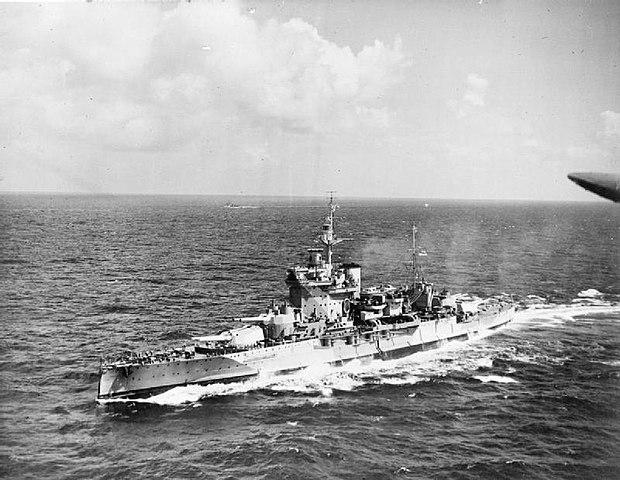
The Great drop of the interwar
It is useful to recall the might of the Royal Navy in 1918. As the first nation to embark on the Dreadnought type, showing the way forward, the Royal Navy had the greatest dreadnought fleet of any nation. Calibers started at 12-in (305), then 14-in (340) and 15-in (381). Added to this, the Royal Navy still boasted the largest fleet of pre-dreadnoughts. In 1919, it was still question to keep at least the largest part of the dreadnoughts.
The Washington treaty limitations
The Washington treaty, signed in 1922 however, ruined these prospects entirely. Drastic cuts into the tonnage and self-evident choices left the Royal Navy with the very latest dreadnoughts in service, those completed shortly before or during the great war, to summarize, the Queen Elisabeth (1913) and the Resolution (1915) classes, notably for the sake of standardization.
Non-standard but recent ships like the Iron Duke class (14-in artillery) were disarmed or converted as training vessels for some time, whereas the HMS Erin (a Turkish order) was discarded, and Canada, paid by Chile before the war, returned to its original owner. Choices were made for battlecruisers also, and they were, again, self-evident.
Notably the two Renown class ships, state of the art in 1917, and the Hood, the mightiest ship in the world at that time, were kept. The “admiral” class was cancelled, leaving only the Hood being completed, in 1920. UK won the same ratio as the US, compatible with its “two fleets policy”, of 5 compared to other nations (3 for Japan, 1.75 for France and Italy).
The motivation behind the Empire was quite simple: The British perspective showed concerns that the United States could expand its naval program, catch up and even topped the Royal Navy. The policy of having twice the tonnage of both best navies united cracked up after the Washington treaty and good relations with the US never excluded some scenarios due to the American isolationism, like “War Plan Red”, declassified in 1974 and causing a stir in these relations.
Consequences
The two major sets of consequences of the treaty for WW2 British battleships were:
-Quantitative: Ban on construction, and tonnage allocation that necessitated the scrapping of 24 British battleships (versus 26 American and 16 Japanese warships). This ban expired at the end of 1936. There was a global 525,000 tons limitation on capital ships (135,000 tons on aircraft carriers).
-Qualitative: Capital ships were defined as above 10,000 tons displacement above 8 inches guns, and under 35,000 tons /16 inches guns.
There were of course exceptions: The WW2 British battleships Nelson and Rodney were already in construction in 1922, just barely started. They could have been scrapped and the material recycled like many immediate-post war capital ships in construction elsewhere, but UK obtained a derogation to the ban, provided that enough older dreadnoughts were scrapped. Indeed, the Iron Duke class was initially planned to stay in service until the late 1930s, and be modernized. They were ultimately the sole, and smaller of the G3 type, pre-Washington concepts, in service by 1926-27. They proved their worst during WW2 at several occasions but never had the chance of “crossing the T” of an enemy fleet, as planned.
The last dreadnoughts
The last capital ship to be later part of WW2 British battleships were completed during the great war was HMS Ramillies, of the Revenge (Or Resolution) class, in December 1917. Construction has been postponed and resumed in one year before the launch and completion. HMS Renown, Repulse and Resistance were also planned, but they saw their construction suspended on 26.08.1914 and never resumed. The names were soon given to new battlecruisers, a more promising breed at the time (Before the battle of Jutland).
There were no plans for more battleships at that time, until 1918 and V-Day, when personal returned to various yards, allowing to envision new capital ships, taking in account lessons from the war. HMS Hood was already modified during construction to incorporate these. In addition, British engineers had an insight into German battlecruiser construction (notably the Hindenburg), seeing how it was advanced in its protection design. Nothing was lost for the development of future British battleships during the interwar.
Keeping the pace: New capital ships designs
It’s only from 1919 that a new design, to be completed in 1922, was started, almost from a blank page whereas the Queen Elisabeth and Revenge (or Royal Sovereign) classes proceeded from a steady evolution since 1911. This culminated with the N3 design, much in line with the G3 class battlecruisers, that they were supposed to complement. After the ban was lifted and the two conferences of London, 1930 and 1935, the Empire has free hands to consider new battleships, taking in account the technological evolution in ballistics and protection.
This will led to the King Georges V, almost considered as a stopgap class, and the Lion class, considered as the “real deal”. Just like many other nations, WW2 broke out whereas these ambitious naval plans were shattered. Very few knew at this stage that the days of battleships, kings of the seas since 1860, were counted. WW2 British battleships were the last of their kind, and the Vanguard the very.
British fast dreadnoughts projects (1918-22)
The N3 design was designed to retake the initiative in gunnery, having slipped through US and Japanese advances in this guide recently, with the Nagato (1919) and West Virginia classes, armed with eight 16-in guns instead of the 15-in. Not to be undone, the new battleships had to scale up to this caliber but also, having more guns than their rivals thanks to triple turrets instead of twin ones. This was quite a design challenge, as turrets of this weight has been never done. In addition both the US and Japanese already had 18-in guns capital ships in construction at that time. Jumping directly to this caliber was envisioned…
G3 class battlecruisers (Project – 1921)

Conway’s reconstruction of the G3 design from original sketches
The G3 project was a battle cruiser study launched right after the end of the First World War, in order to stay in the arms race led by the USN and IJN. The Washington Treaty of 1922 prohibited the construction 35,000 tonnes plus ships, therefore since the design was too far advanced to be revised, cancellation followed on February 13, 1922. If built, the two ships probably had replaced the Renown class ships due to tonnage limitations.
The Royal Navy was aware being later in the game whereas the American and Japanese navies accumulated new projects and launched new designs. Most British dreadnoughts of the time were still armed with 12-inch (305 mm) guns and even 13.5-inch (343 mm)/15-inch (381 mm) ships were already obsolescent. This irony of being the first in the game. The last USN (West Virginian class) and IJN (Nagato class) super-dreadnoughts were already armed with 16 inch (406 mm) guns.
The admiralty in 1919 envisioned its options. Complete reconstruction of battleships already armed with 381 mm guns, the Resolution and Queen Elisabeth class namely could solve part of the issue to stay on course, however a new class was needed to compete also, armed with 16-in/18-in guns. Also it was specified to incorporate the lessons learned during the war in the new design, in particular at Jutland. The Admiral class (HMS Hood) was essentially a pre-Jutland design, and by 1921 many tests on the Hindenburg, Bayern, Baden and other German capital ships scuttled in Scapa Flow helped to secure additional knowledge on the optimal protection scheme.
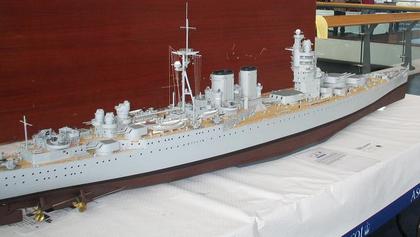
A model of the G3
The first project put on track was a class of four large battlecruisers, whose construction was scheduled to start in 1921. The concept evolved into a class of fast battleships with the US-inspired “all or nothing” scheme. The latest types of armoured were to be used, with a sloped internal armor plus the latest generation anti-torpedo bulges.
For the first time, triple turrets were envisioned. This was to achieve a compromise: Concentrating the main armament at one spot allowed to also concentrate armour, thus saving weight. The G3 secondary armament took the form of twin turrets. Drafts were ordered to test various configurations on this common base, all having in common the concentration of armor and more possible compact turrets/barbettes/magazines immune zone. These innovations represented quite a dramatic improvements over previous designs, allowing the poerplant to deliver much better speeds. By then the revolutionary HMS Dreadnought was 17 years old, and the “super-dreadnought” concept dated back six to seven years. A new generation, the “fast battleship” was on her way.
The G3 final design was eventually internally accepted in the Admiralty in February 1921. It was validated by the parliament in August and orders were placed on October 26. The yards responsible to deliver them were William Beardmore, John Brown, Fairfield Shipbuilding and Swan Hunter. Machinery was sub-contracted to Parsons. By November 18 however, the Cabinet vetoed the order. Construction of these ships was by then used as leverage in the negotiations during the Washington conference. However what prevailed were concerns of a financial crisis, and the expenditure was put into balance with the fact the Americans and the Japanese would even went on with their own construction.
No keel was put in the slip so these ships are purely paper projects, despite the fact they went so far. The time spent to their study was not lost anyway and was recycled entirely into the two Nelson-class battleships design. That’s why the only representations of the G3 looks eerily similar to the latter. Basically the Nelsons were a truncated version with the same armament and armor, but due to the reduction of engine power, they were slower, loosing 8-9 knots. In the end, the four G3s were officially cancelled on February 13, 1922. No names were ever to be assigned, although there are much chances for them to be named after admirals.
Specifications
Dimensions: 260,9 x 32,3 x 10,2 m
Displacement: 48,400 tonnes – 53,909 tonnes FL
Propulsion: 4 shafts turbines, 20 boilers, 160 000 hp
Range: 7 000 nm (13 000 km) @ 16 nots (30 km/h)
Top speed: 31,5 nœuds (58,3 km/h)
Armament: 3 × 3 16-in, 8 × 2 6-in, 6 x 4,7 in, 4 × 8 2pdr AA, 2x 622 mm TTS, 2 seaplanes
Armor: See notes
Crew: 1710
N3 class battleships (1922)

Conway’s reconstruction of the N3 design from original sketches
In addition to four battlecruisers for 1921 the Admiralty hoped to lay down four battleships in 1922. The design which evolved was broadly similar to the G 3′ battlecruiser design, but with only half the horsepower, as speed was cut to 23-234kts (the speed of the battlefleet). The main armament was to be three triple 18in (457 mm) guns, of a new 45 caliber type, firing a 837lb shell at a muzzle velocity of 2837fps. Experience with the blast effects of the triple 16in was later to suggest that the theoretical power of he 18in would have been outranked by the appalling blast-effects on decks and superstructure. So the N3 would have been much better armed on the same displacement, at the expense of a slower speed.
The four ships planned were still at an early design-stage when the Washington Treaty put an end to all plans for large capital ships. Like the
‘G 3’ design they would have been cancelled at the insistence of the Treasury, even without the Treaty, but they remain the most powerfully
armed British battleships of all times… never built. Src: http://steelnavy.com/images/IHPStAndrewN3/Andy1369box.JPG – The N3 “fleshed out”.
Specifications (as estimated)
Displacement: 48,500 tonnes standard, 52-55,000 FL
Dimensions: 250 x 32.3 x 9.9-10.1 m
Powerplant: 4 shafts single reduction geared steam turbines, 12? oil-fired boilers top speed 28 knots
Armament: 3×3 18-in/45 (457 mm) MkII guns, 8×2 6-in Mk XXII, 6x 4.7 in/43 DP, 4×10 2-pdr PomPom
Armour: As G3
Post-Ban: The Lion class battleships (1940)

Conway’s profile of the Lion class
It is established by most authors and researchers on the topic that the King Georges V was a stopgap class. In 1939, even when completion of the class was a long way ahead, its low caliber made them inferior to many designs of the time, including old ones such as the Japanese Nagato class, the French Richelieu, the Italian Litorrio, or of course the Bismarck. The real war time class was the next one, based on this design but large enough to accommodate three triple turrets with 16-in guns, basically the same as the Nelson, but much faster. War broke out far sooner everyone expected.
This class were to have been built under the escalation clause of the London Treaty which allowed 45,000t and 16in guns, and were far nearer the Navy’s requirements than the King George V. It does not appear to have been realised that Japan, Russia and Germany had already started or were about to lay down ships approaching or exceeding 60,000t, and British political thinking of the day kept the Lion class to near 40,000t. In general layout and appearance they would have resembled the King George V but with a transom stern. The 16in guns and mountings were different from those
in Nelson, being designed for a 2375lb instead of a 2048lb shell.
The lower strake was continued as in King George V. The main turrets had 15in faces, 10in-7in sides, 7in rears and 6in roofs; deck, underwater and other protection was as in King George V except where indicated above, with the addition of 2in between the lower deck and inner bottom below the
citadel bulkheads. The turbines and boilers were arranged as in King George V.
Other wartime needs forced the belt was a uniform 15in between barbettes with a 54in lower edge, and at 33ft 6in mean draught extended from 11ft above to 12ft below water. The suspension and then cancellation of this class, but under the 1945 Programme it was intended to lay down the Lion and Temeraire to a new design in 1946 for completion by 1952. Full details of this design have not been found, but the upper limits were 50,000t standard with dimensions of 840ft x 118ft, and figures of 56,500t deep load and 810ft x 115ft x 34ft 3in mean at this displacement have been quoted.
The armament would have comprised 9-16in/45 Mk IV guns in a new type of triple mounting designed to have a firing interval of 20 seconds per gun instead of the usual 30, with 24-4.5in/45 QF Mk V guns and 10 6-barrelled Bofors mountings. Oil fuel capacity would probably have been between 5000 and 6000t and speed about 29kts. The increased beam would have allowed much improved torpedo protection probably against a 2000lb TNT charge.
The project seems to have been abandoned because 12in deck armour was found to be necessary against possible AP bombs, and this would have required a much larger ship. The economic condition of Britain would in any case have forced the cancellation of these ships.
The case of Vanguard (1946)

The idea of building an entire battleship based on spare turrets dating back from WW1 seems ludicrous at first glance, especially if the ship in question missed WW2 entirely. But it was the case for the Vanguard, the last British Battleship.
This ship’s origins go back to an early 1939 project for utilising the 15in turrets from Courageous and Glorious in a 30kt ship for the Far Eastern fleet. The sacrifice in using these venerable turrets was less than might appear as they were a reliable and satisfactory design which could be modernised and given 30° elevation with thicker face and roof plates, and the 15in gun was only about 30fs down in muzzle velocity compared with a new British design.
The one serious fault was that the turrets were designed for a ship below the with shell rooms magazines, and for the contrary arrangement, which was now standard practice, it was necessary to have the magazine handing rooms on the lower deck above the shell rooms with fixed hoists from the magazines down below. Although outwardly of different appearance, Vanguard resembled King George V in many ways.
The 5.25in guns were in improved mountings and there was no provision for aircraft. The belt was reduced to 14in abreast the magazines and 13in
elsewhere with a uniform 4lin lower edge, and the lower strake was continued for some distance at 13in-1lin with a 4 in lower edge. The main tur-
rets had 13in faces, 9in-7in sides, 1lin rears and 6in roofs.
The main deck armour was 6in over the magazines and 5in over the machinery, and the lower deck was 5in-2 in forward and 4 in-23in aft. The 5.25in guns had 2in-1in and there was more splinter protection than in including 2bin-2in on the sides between the middle and lower decks beyond the heavy belt and extending nearly to bow and stern. The torpedo protection was similar to that in King George V with a 11in-1in protective bulkhead, and the compartment bulkheads outboard of this were taken to the middle deck instead of ending at the lower deck. At the most favourable position the system was designed to stand 1300lb TNT.
At deep load metacentric height was 8.2ft with a stability range of 68°. The main machinery was arranged as in King George V, and on the mile at 45,720t Vanguard developed 136,000shp 31.57kts. As a result of war experience Vanguard had a transom stern and a marked sheer forward, which made her a much better seaboat than previous British battleships. Tactical diameter at full speed was l1025yds. As often happened, weights increased
during construction and 770t had to be added to the upper deck structure to meet the resultant higher stresses. The machinery was arranged as on the King George V, and on the mile, the Vanguard developed 136,000 hp for a top speed of 31.57 knots as measured on trials. There were were 4 diesel and four turbine-driven dynamos instead of two and six respectively.
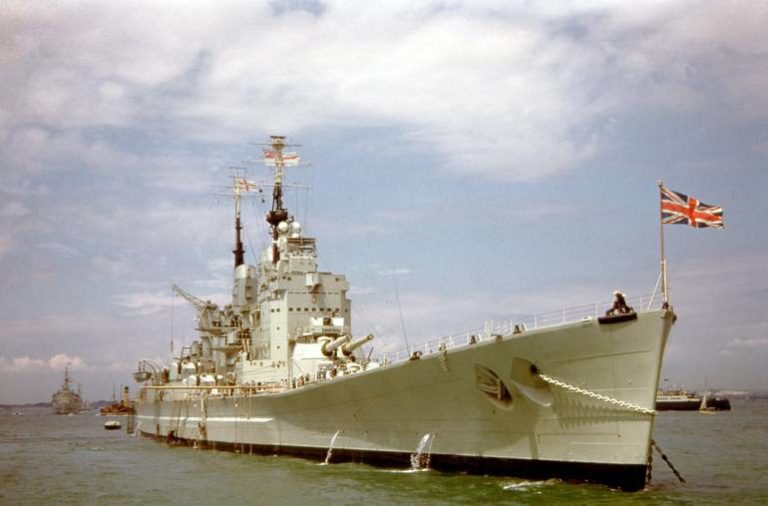
British Battleships armament
18″/45 (45.7 cm) Mark II (Never issued) G3-B3 and other 1920 projects
16″/45 (40.6 cm) Mark I Nelson and G3 class guns
15-inch (38.1 cm) Mark I: The mainstay of high caliber in the RN: Hood, Repulse class, Queen Elizabeth, Royal Sovereign and Vanguard classes and monitors
15″/45 (38.1 cm) Mark II: Project alternative for the KGV class
14-inch (35.6 cm) Mark VII: King Georges V class battleships
12″/50 (30.5 cm) Mark XIV: Experimental 1930s “light” heavy gun
Src: http://navweaps.com/Weapons/WNBR_Main.php
16″/45 (40.6 cm) Mark I
They were the last wire-wound guns built for the Royal Navy, and the only ones fitted in triple turrets. The measure was to save weight: By concentrating all three turrets on a reduced area, the citadel armour can be concentrated in a short length and thus considerably reducing the displacement. This was an all-or-nothing scheme borrowed to US practice. Thus later confirmed the adoption of quadruple turrets for the Dunkerque and Richelieu class, although previous Normandie and Lyon class battleships of 1913-1916 already adopted them.
Famously inadequate firing trials convinced the Director of Naval Ordnance (DNO) that high-velocity, low-weight projectile were superior in penetration at large oblique angles of impact. This led the admiralty to be forced to adopt a lightweight APC projectile on the future King Georges V class studied from 1932. As the furst 16-in guns in British service (and last), these had teething problems with liner wear, interlocks and turret roller-bearings. In 1939 they all had been mostly ironed out. They proved more reliable than the 14″ (35.6 cm) mountings of the KGV class anyway.
29 in all were Manufactured by Elswick, Vickers, Beardmore and the Royal Gun Factory. These were 18 guns used by the Nelsons and spares. They were made for a tapered inner A tube with two rear locating shoulders, full length taper with wound wire, and a B tube with overlapping jacket and breech ring. There was also a shrunk collar at the rear of the A tube. The breech bush was used to attach the Welin breech block driven by an Asbury hydraulic system.
Details of the 16-in gun
Weight: 106 tons (108 tons With Breech mechanism)
Barrel Length overall: 742.2 in (18.852 m)/Bore 720.0 in (18.288 m): 45 calibers
Rifling Length Mark I: 586.96 in (14.909 m)/Mark II 588.95 in (14.959 m).
Grooves Mark I: (80) 0.135×0.377 (3.43×9.577 mm)/Mark II (96) 0.124×0.349
Lands Mark I 0.2512 in (6.380 mm)/Mark II 0.1745 in
Twist: Uniform RH 1 in 30, Chamber Volume 35,205 in3
Rate Of Fire around 1.5 rounds per minute
Ammunition: Bag type,
Ammo Weight: AP (Mark IB) 2,048 lbs. (929 kg), HE 2,048 lbs. (929 kg)
Bursting Charge: 51.2 lbs. (23.2 kg) on AP
Length (AP/HE) 66.23 in (168.2 cm)/75.94 in (192.9 cm)
Propellant Charge 1930: 495 lbs. (224.5 kg) SC280
Muzzle Velocity: Mark I rifling: 2,586 fps/Mark II: 2,614 fps (797 mps)
Working Pressure: Mark I 20.0 tons/in2 (3,150 kg/cm2)/Mk.II 21.3 tons/in2 (3,355 kg/cm2)
Barrel Life (approx.) 200 – 250 rounds
Ammunition stowage (per gun) 95 APC, 10 practice rounds
15-inch (38.1 cm) Mark I:
The mainstay of British main guns in WW2. It as certainly the best large-caliber naval gun ever developed by Britain and longest-lived, with more “kills” to its credit than any other piece of naval ordnance.
It was developed in wartime and strangely for such a famous gun, had a botched development. It was based on the proven 13.5″/45 (34.3 cm) Mark V and rushed into production bypassing all standard trials procedures usual in peacetime. The gun was passed in force by the Director of Naval Ordnance, Rear Admiral Archibald Moore, which guaranteed its reliability on his head. This allowed the Queen Elizabeth class battleships to receive it unlike the earlier which should have been installed as a stopgap measure. The next “R” was the one which should have receive it instead.
These guns started to voice at Galipolli in 1915 and really made their legend felt at Jutland the next year. In the 1930s, the guns seemed obsolete and started to wear out after 20 years of regular service. However inhibited by treaty restrictions the admiralty could only modernize the ships that carried them and their mount. The upper elevation limit was raised to 30° allowing a greater range at 29,000 yards (21,670 m to 26,520 m) whereas the projetile was refined, with a more carefully streamlined ballistic cap (6crh) to reach 32,000 yards (29,260 m) at max elevation. This allowed for example something unheard of in WW1, the famous July 1940 HMS Warspite hit on the Italian battleship Guilio Cesare at 26,000 yards (23,770 m). This convinced the Italian admiral to “fold up” and leave, ending the battle.
However this modernization process took time and need financing, and therefore Malaya, Barham, Repulse and the five Royal Sovereign class did not have this advantage in 1939. To compensate, some ships were given a “Super Charge” to boost artificially the range up to 28,700 yards (26,240 m), wearing the barrel down. They seemed to have never been used however in practice. Only Dover guns used them in one occasion, when the Schrarnhorst and Gneisenau made their run from Brest to Germany via the channel. The Singapore fortress also used them.
186 of these guns were manufactured in all, mostly by Vickers, plus 58 turrets until 1918. They were made of a tapered inner A tube, with full-length multi-start wire, and a B tube with overlapping jacket and breech ring. They used the proven Welin breech, operated by an hydraulic “pure-coupled” mechanism. The last to be installed with on the Vanguard, which could have been fired during the operation Musketeer (The Suez crisis) in 1956, but were not.
Characteristics
Gun Weight: 224,000 lbs. (101,605 kg) with breech mechanism
Gun Length: 650.4 in (16.520 m), Bore 630.0 in, Rifling 516.3 in (42 calibers)
Grooves: (76) 0.1245×0.445 (2.16 x 11.30 mm) lands 0.175 in, Twist Uniform RH 1 in 30
Chamber Volume: 30,650 in3 (502.3 dm3)
Barrel life approx. 335 rounds, 100-120 rounds per guns carried.
Rate Of Fire: 1-2 rpm nominal firing cycle Mark I/I* mounting: 36 seconds
Propellant: 432 lbs. (196 kg) SC 280/Super charge: 490 lbs. SC 300
Ammunition weight (ww2):
-APC Mark XIIa (4crh) – 1,938 lbs. (879 kg)
-APC Mark XIIIa (4crh) – 1,938 lbs. (879 kg)
-APC Mark XVIIb (6crh) – 1,938 lbs. (879 kg) 3b 4b
-APC Mark XXIIb (6crh) – 1,938 lbs. (879 kg)
-HE Mark VIIIb (6crh) – 1,938 lbs. (879 kg)
Muzzle velocity (ww2):
-APC 4crh – 2,467 fps (752 mps)
-APC 6crh (standard charges) – 2,458 fps (749 mps)
-APC 6crh (super charges) – 2,638 fps (804 mps)
14-inch (35.6 cm) Mark VII
This “stopgap” caliber was used on the King Georges V class.
The problems resulted with the brand new 16-in guns on the Nelsons and the erroneous belief that lower velocities, but higher trajectories and lighter shells had greater penetration power conducted the DOA to issue an order in 1930 for a new caliber. The decision to adopt the itermediate 14″ (35.6 cm) guns was also in order to comply with Treaty restrictions. But this had severe consequences as the KGV ended in WW2 as the weakest modern armed battleships in service.
It was based on the experimental 12″/50 (30.5 cm) Mark XIV, tested which “all-steel” construction techniques, notably being the first designed for a cast steel cylindrical cradle. It was an anticipation on further gun caliber limitations that never went to fruition. This model had atapered inner A tube, with jacket and breech ring with bush and shrunk collar and used a Welin breech block with Asbury breech mechanism. The same principle was used for the 14-in. The no-wire, radial-expansion construction allowed to make a lighter barrel. It was more accurate and had a longer barrel life, but its mount soon prove troublesome. Mechanical failures indeed accumulated to such a point the brand new Prince of Wales was not ready when engaging the Bismarck and had to retire due to these problems.
Fortunately these defects has been irone out in such a way at Battle of the North Cape on 26 December 1943, HMS Duke of York scored 46 hits to sink the Scharnhorst without a problem. This were two series of 52 broadsides fired and later 25, scoring 21 straddles out of the latter, quite an achievement for the time, well helped by new radar-guided firing control and much improved ballistic computing. These guns also were the first with a recoil in a cast steel cradle rather than on slides. In all 78 guns were made, 24 by the Royal Gun Factory, 39 by Vickers-Armstrong, Elswick and 15 by Beardmore. An improved loose barrel version was to be produced called the Mark VII*, later cancelled.
Characteristics
Barrel Weight: 79.588 tons (80.865 mt)/78.988 tons (80.256 mt)
Length oa: 651 in (16.532 m), Bore 630 in, Rifling 515.7 in 45 cal.
Grooves (72) 0.117 in deep x 0.3665, Lands 0.2444 in, twist Uniform RH 1 in 30
Chamber Volume : 22,000 in3 (360.5 dm3)
Rate Of Fire: 2 rounds per minute
Muzzle Velocity: 2,483 fps (757 mps) up to 2,850 fps supercharged
Working Pressure: 20.5 tons/in2 (3,230 kg/cm2)
Approx. Barrel Life: 340 rounds
Ammunition stowage: 100 rds/gun
Propellant Charge: Standard: 338.3 lbs. supercharge 486 lbs.
Projectile weight: APC Mark VIIB 1,590 lbs. (721 kg)/HE 1,590 lbs. (721 kg)
Bursting Charge: 48.5 lbs. (22.0 kg), Length 61.6 in (156.5 cm)
British Battleships in action
The great lesson of WW2 is of course the shift between battleships and aircraft carriers. Six years of war would cement the idea, bit by bit, into the press and naval staffs. What was at the start an auxiliary of the fleet became a capital ship all of its own. Taranto, Pearl Harbor and Midway greatly accounted for it. Nevertheless, battleships did took part in many naval engagements during this war, although their role shifted towards shore bombardment only as the war progressed and axis fleets were wiped out. British battleships played their part in these engagements. Perhaps the best known were the Queen Elisabeth serie, and in particular HMS Warspite, a veteran of the Mediterranean.
On the twenty British capital ships that took part in World war two, six were lost in action:
–HMS Hood by gunfire, in her famous duel vs. KMS Bismark in May 1941
–HMS renown by aviation, as part of Force Z in dec. 1941
–HMS Royal Oak by an U-boat at Scapa flow in October 1939, just one month after the war started, a bad omen for the RN
–HMS Barham also by an Uboat in the Mediterranean in November 1941
–HMS Prince of Wales by aviation in dec. 1941, as part of Force Z
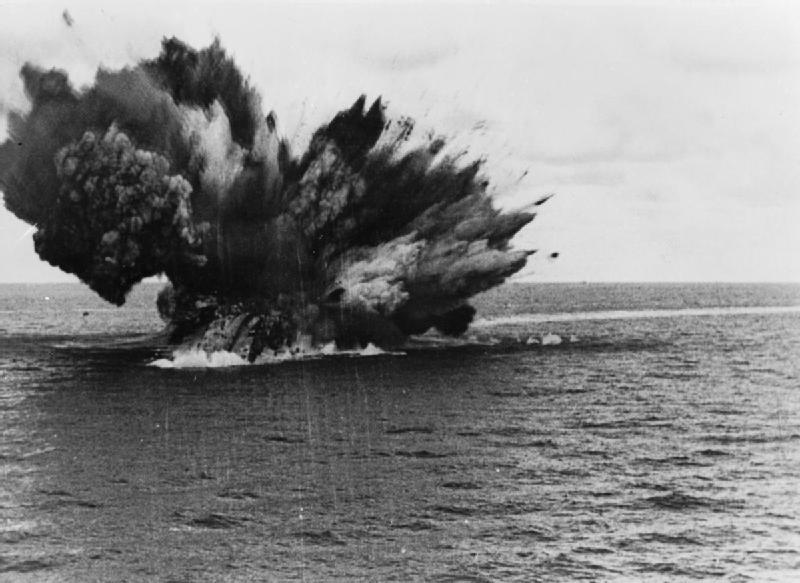
What we can conclude from this ?
1-Battlecruiser were condemned. Poor protection eliminated two out of the three last of the type.
2-Gunnery duels are no longer the order of the day: Only Hood was sunk this way
3-The Underwater threat is very real, with two battleship sunk despite their own bulges and compartimentation
4-The air threat is also very real, including from traditional bombers as shown by the PoW and Renown.
New air and ASW threats shold we conclude are the main enemy of battleships, more they are a threat for themselves.
This is also due to the relative weakness of Axis naval powers, to compare to WW1. In terms of tonnage, Japan took the place of the Kaiserliches Marine. The Kriegsmarine was too weak to face the RN in a traditional way and was used to disrupt trade, whereas the Regia Marina was plagued by poor coordination with aviation and timid command. This left few occasions for British battleships to shine in battle. Repartition of tasks between the allies meant none would ever face IJN capital ships. This left only a few encounters with Italian and German capital ships, far in between.

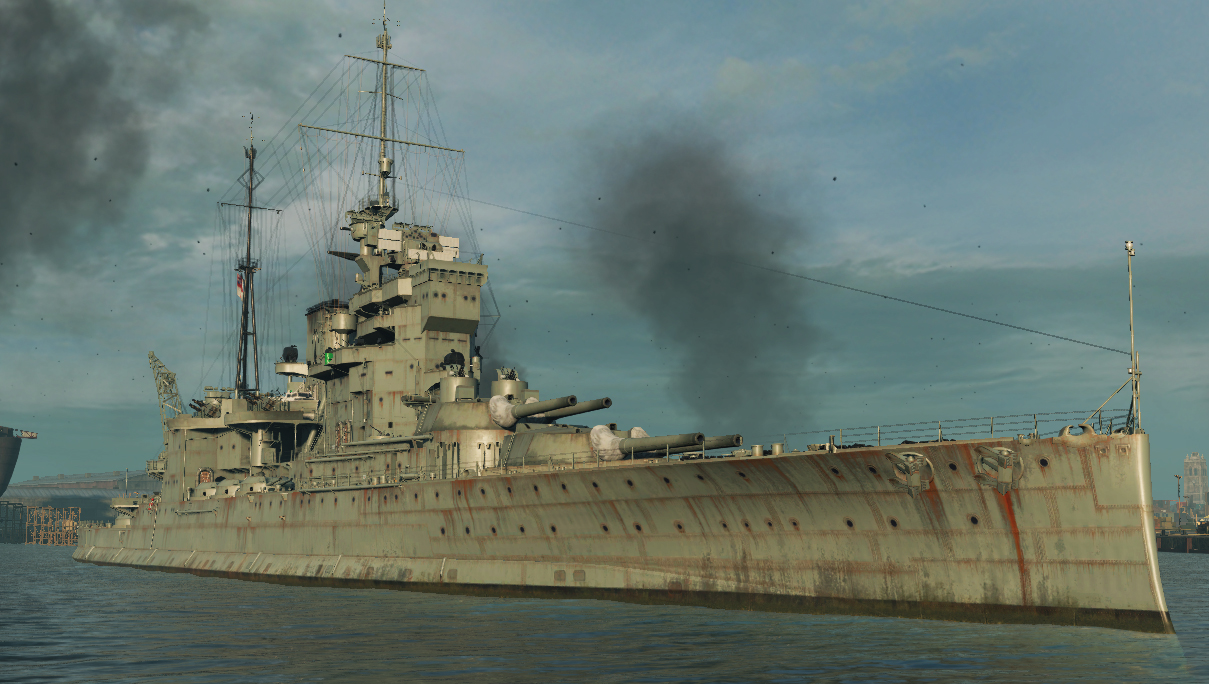
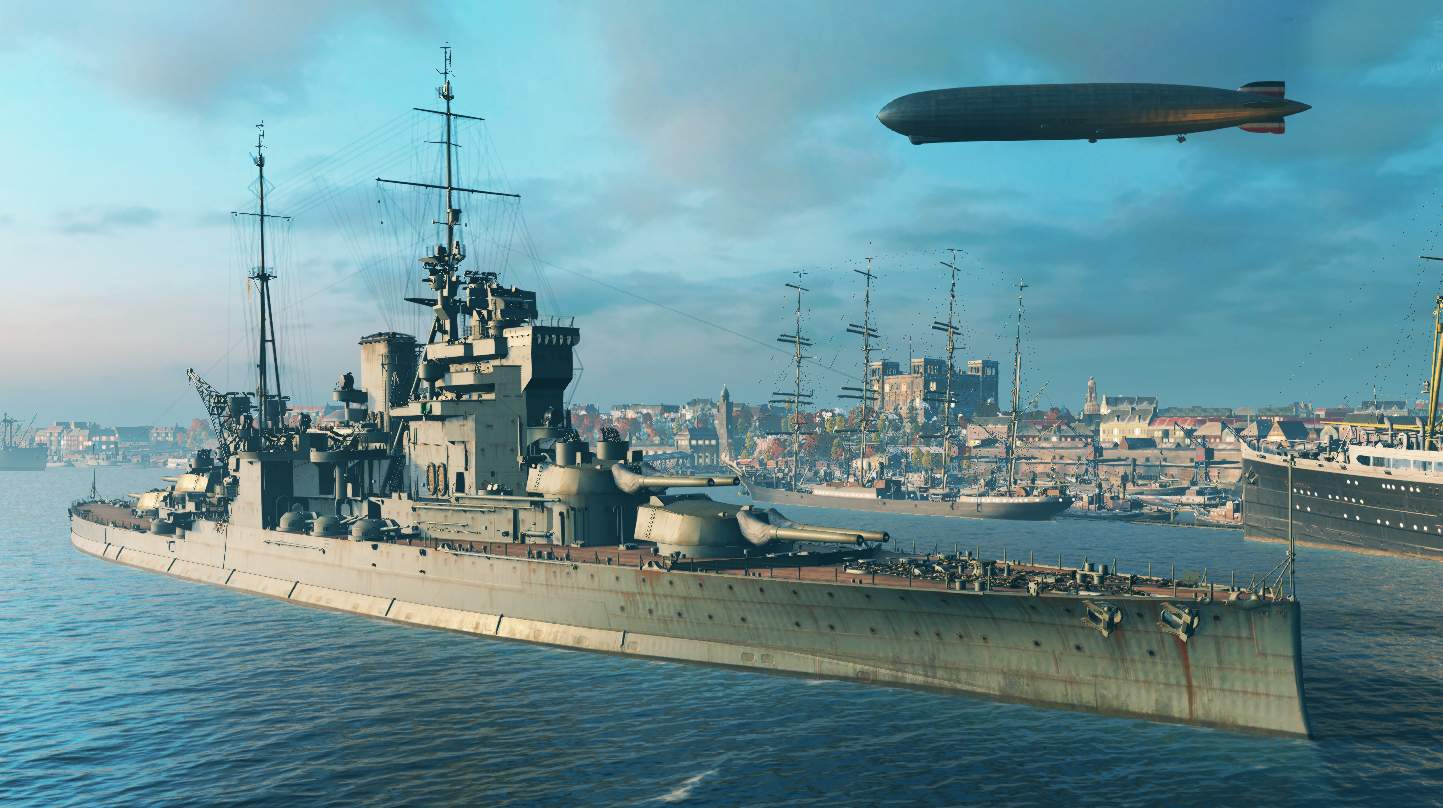
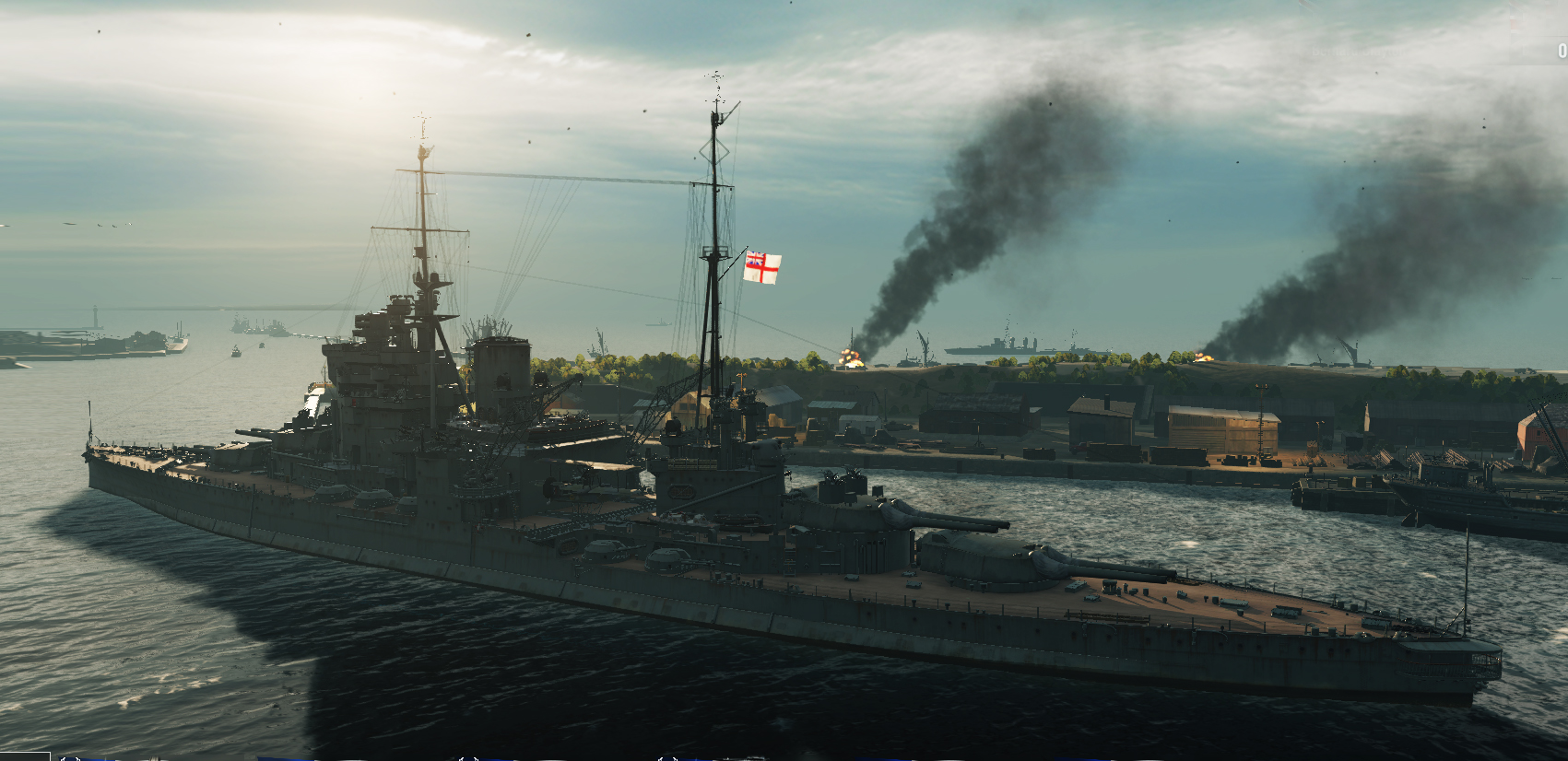
WoW’s renditions of the Queen Elisabeth after refit
Now let’s have a deeper look at these classic naval battles:
Norway, 13 April 1940: The Warspite and nine destroyers destroys eight German destroyers in Narvik. Hardly a fair fight… With previous losses, Norway claimed 50% of the Kriegsmarine’s destroyer strength.
The Mediterranean
Mers-El-Kebir, july 1940: Resolution, Valiant and Hood shelled French ships at anchor. Hardly a fair fight also, and controversial at that.
Punta Stilo, 9 july 1940: HMS Malaya, Royal Sovereign and Warspite engaged the Italian fleet and notably the comparable Cesare and Cavour. Fair fight but not a decisive battle as the Italian quickly broke off.
Matapan, March 1941: Relatively Unfair fight (the British has four BS vs one, plus radar and a carrier), decisive British victory against heavy cruisers, the Veneto, only real threat of the Italian fleet, is badly damaged. Later in Crete, HMS Warspite and Valiant would be damaged by Stukas, by far more redoubtable than the Regia Marina for the RN.
The hunt for Bismark, May 1941: Fair fight (arguably), HMS Hood and Prince of Wales engaged the Bismarck and Prinz Eugen. Both British ships performed poorly for their own reasons: Hood’s protection was deficient, whereas PoW’s was too green and riddled with tech problems. Later, the Rodney and King Georges V joined the fray and that moved into an unfair fight as Bismarck was no longer master of its steering anymore. This was the most serious test for British capital ships in the whole of WW2 and for this reason is vividly remembered.
December 1941, the loss of the PoW and Repulse only tells that AA artillery was unable to stop waves of high altitude bombers but they had little success. Torpedo bombers really were those carrying out the decisive hits. Despite of this at Midway, the US launched a B17 attack over the IJN fleet.
For Malta, British battleships were rarely committed as “bomb alley” could have been fatal. They were much too precious to waste in an escort mission, even after the Italian capital ships losses. In Alexandria, the loss of HMS Queen Elizabeth and HMS Valiant were due to swimmers, and they were the best success of the Regia Marina in this war.
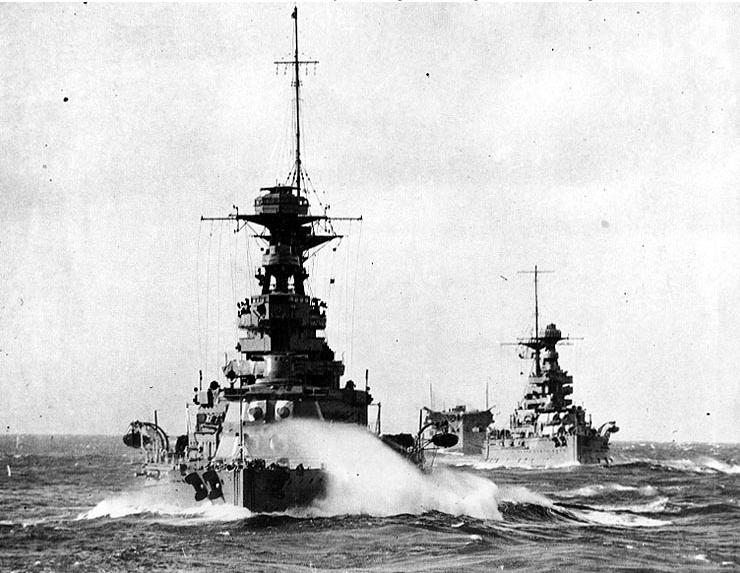
During Operation vigorous in june 1942, HMS Malaya was there only to procure a distant cover. She did not really took part in the battle. Two battleships were present during Operation Pedestal in August 1942. These were the Nelson and Rodney, covering the task force of three aircraft carriers. Like in the Pacific, the shift was clear here. From there, British Battleships would participate in the Italian campaign and Operation Torch until the Italian capitulation, there was no serious threat to face in the Mediterranean and battleships mostly were used for shore bombardment.
The north sea
More serious were the threat posed by the Kriegsmarine in Norway, threatening convoys of the Atlantic and to Murmansk. The decisive moment was the Battle of the North Cape in December 1943. This was mostly interesting because of the duel between the Scharnhorst and Duke of York, the last “fair” fight between capital ships in this apart of the world at that time. Not surprisingly, Scharnhorst’s high speed was no substitute for weak firepower and she was sank. By the same time, KMS Gneisenau was a written off and the surviving pocket battleships saw little action until 1945. Only KMS Tirpitz posed a realm threat, acting as a dissuasion force all by herself for a Norwegian fjord. There were missed opportunities of duel with HMS Duke of York or the battlecruiser HMS Renown, and the KGV but her fate would be ultimately decided by aviation and midget subs. The threat was such that the Royal Navy leased to the Soviet Navy, badly crippled since 1941, the battleship Royal Sovereign, renamed Arkhangelsk.
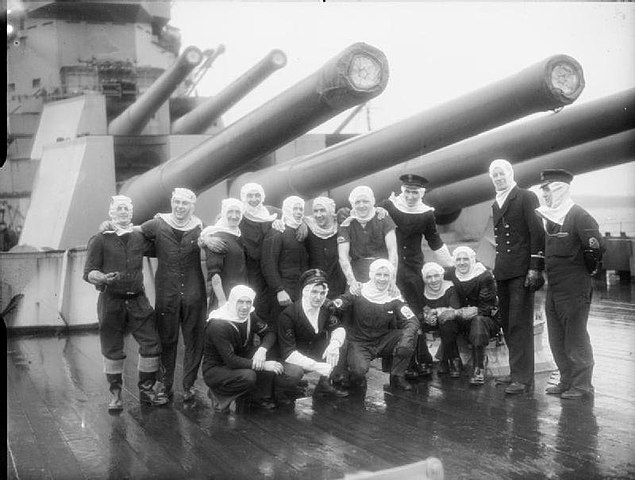
Gunners of HMS Duke of York posing after the battle of north cape which saw the destruction of the KMS Scharnhorst.This was the last battleship duel of the war in the West, and one of the last in history
From 1944, the admiralty gave little thought to complete their prewar capital ship program. Extra ships of the King Georges V class were cancelled, as well as the Lion class, of which only the HMS Lion and Temeraire were laid down in June and July 1939. The case of HMS Vanguard is interesting. She was started in October 1941 only to take advantage of the turrets of the battlecruisers Glorious and Courageous converted in aircraft carriers. That was an interesting decision: Would the price of turrets justify the construction of a whole battleship ? What is certain is that the RN badly needed a capital ship for the eastern fleet, as situation with Japan degraded rapidly. Eventually work stalled for a time and she was only completed in August 1946, becoming the last British battleship to see a (short) service until 1960.

HMS Revenge 1942
A short story of Monitors
Although this subject is largely irrelevant as they were not classed as capital ships,lacking the speed to insert effectively in battle lines, Monitors did make good use of heavy artillery on a small package. The British monitor fleet, as a reflection of their massive use in WW1 was the most important in this conflict.
So much so that the last British monitors were built during this war: Roberts and Abercrombie, completed in 1941 and 1943. They added to the Marshal Soult, Erebus and Terror dating back from the great war. Their use was limited nevertheless: Marshal Soult has been already disarmed in 1940, and the two others partially rearmed. All four were active during the war, taking on niche uses, of shore bombardment between various theatres of operations in the Mediterranean and Atlantic, mostly landing operations. Their ASW protection was considerable with massive bulges. As slow and conspicuous targets near the coast they were easy prey for U-Boats.
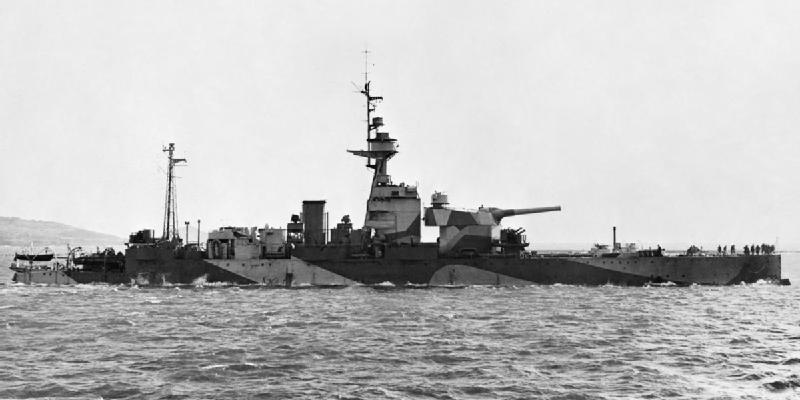
Last of the Mohawk: HMS Iron Duke and Centurion
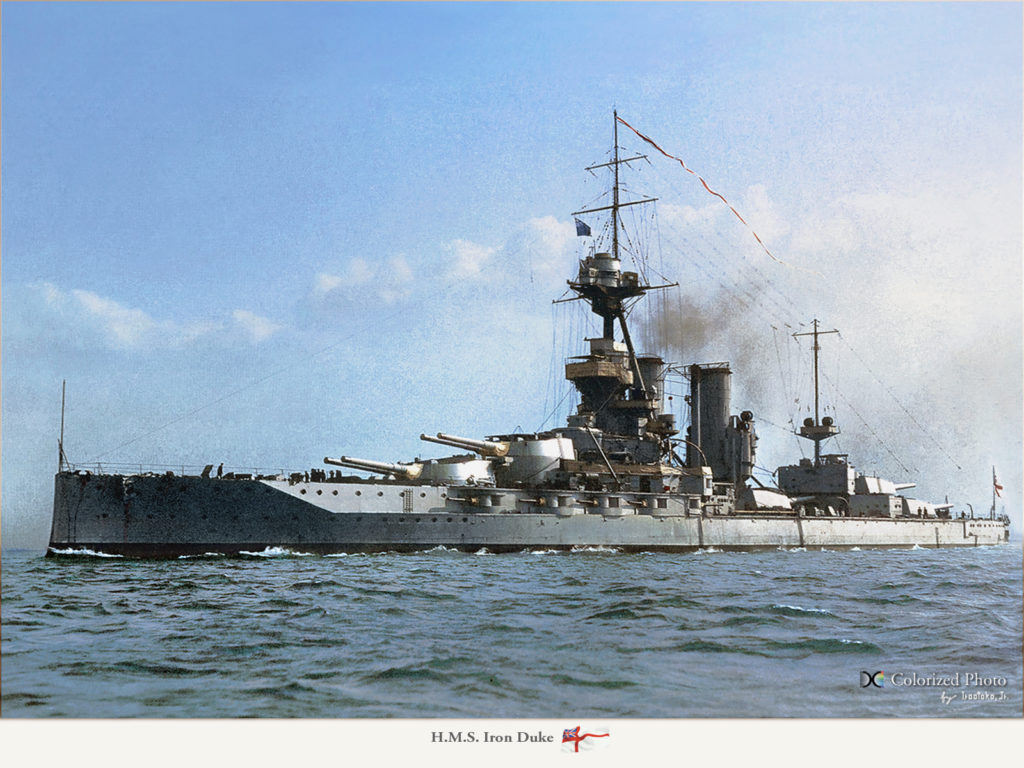
Launched in 1912-1913, the Iron Duke class was the last dreadnoughts using the intermediate caliber of 13.5 in (343 mm)
Displacing 25 000 t standard and 29 560 Tonnes fully loaded, and measuring 189,8 x 27,4 x 9 m, they were propelled by four shafts connected to four Parsons turbines fed by 18 Babcock et Wilcox boilers rated for 29 000 hp, allowing them to reach 21,3 knots. The armor ranged from 65 mm (decks) to 300 mm for the belt, and conning tower. Armed originally with ten main guns in axial twin turrets, completed by twelve 6-in guns, they were the most recent battleships when WW1 broke out.
The Iron Duke, Marlborough, Benbow and Emperor of India (ex-Delhi, renamed), had a relatively light armour which was reinforced after the battle of Jutland where they served with distinction with the 2nd squadron. These ships were discarded and reformed in 1929-32, well after the Washington treaty to respect the tonnage limits (as the Nelson class was completed).
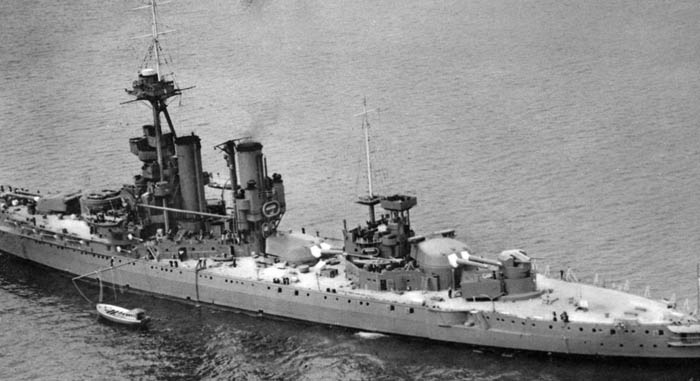
HMS Iron Duke in 1939, partially disarmed at Scapa Flow and used as an experimental AA ship.
HMS Iron Duke was preserved until 1929, and she was radically converted in 1930 as a training ship. Partly disarmed, she was completely stripped of her armor, the engines restrained and speed lowered to 18 knots, in conformity to the Washington treaty exception. She was still used as a training ship in 1939. She was anchored as Scapa Flow, converted as a pontoon and now totally disarmed when the war broke out. By October she was attacked by the Luftwaffe and damaged. She was summarily repaired but left at anchor and broken up in 1946.
Due to wartime, she could have been rearmed, but this was brushed away as far better ships of the King Georges V were already in construction or being completed by that time.
It should be noted that even older dreadnoughts ‘took part’ in WW2: HMS Centurion for example, of the previous King Georges V class, was towed to the Mediterranean, totally disarmed at this point, spending two years fitted with wooden guns and fake superstructures to mimick a QE class ship and makes the fleet stronger than it was.
HMS Centurion disguised as the Battleship HMS Howe
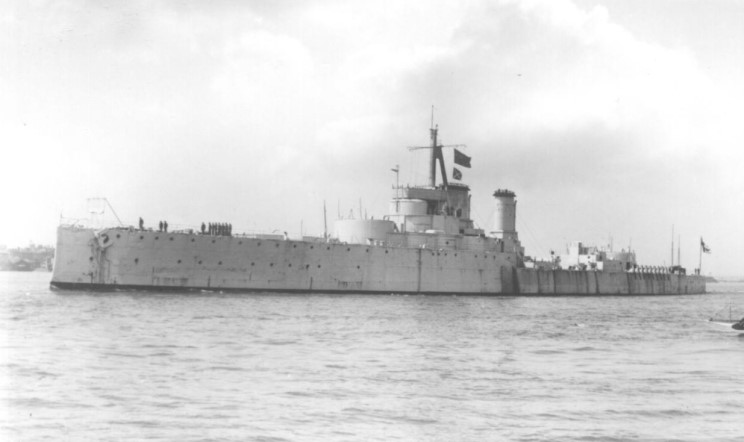
HMS Centurion as a target ship in 1942, before disguise
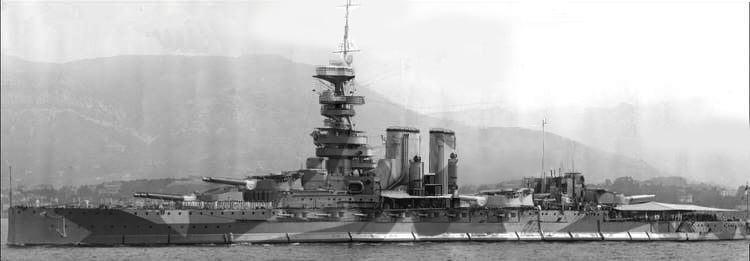
What-if Iron Duke 1942
Renown class battlecruisers (1917)
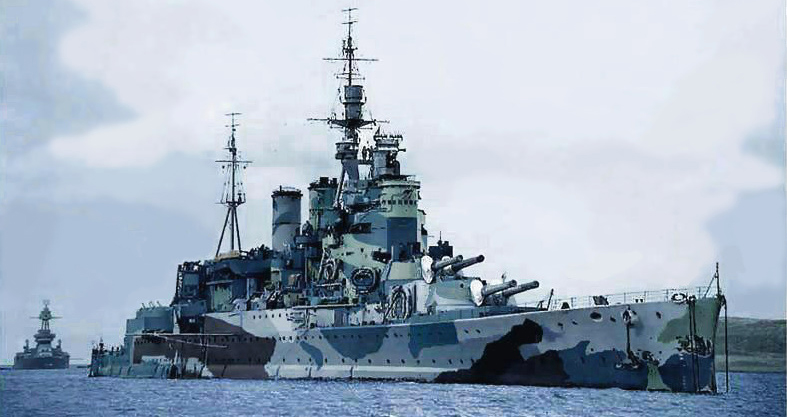
Colorized image of HMS Renown – from reddit/pinterest.
The two battle cruisers Repusle and Renown, launched in 1917 and in service at the end of 1918, barely had time to operate during the First World War. At the time, before the Hood was released, it was the most powerful warship in the world, with unmatched tonnage, size and speed. They were part of the arms race started during the war between all the belligerent nations and which will be condemned and stopped net by the treaty of Washington in 1922.
The underlying idea of the battle cruisers was known in a simple “slogan” and theoretical: Speed is the best protection. Rather than giving a building thick armor, it is given a power unit powerful enough to outrun any battleship, while having the same artillery. In Great Britain, the admiralty had found in David beatty its paragon: Despite the scepticism of John Jellicoe and the first lord of the sea, battle cruisers were started shortly after the release of the revolutionary Dreadnought in 1906, and the Repulse were the last in a long series. Unlike the others, it was “post-Jutland”. Indeed these ships designed in 1916 had incorporated a number of recommendations under construction, concerning the serious limits detected on English battle cruisers during what remains the largest modern surface naval battle in history.
It was not under these auspices that these two giants were built, but as dreadnoughts, improved versions of Revenge (less powerful and faster but better protected). There were three units, Repulse, Renown and Resistance, at Royal dockyards and Palmers. Faced with the first successes recorded by battle cruisers (Heligoland Bay and Falklands), and the combined pressure of Fischer, Jellicoe and Beatty towards Churchill, first Lord of the Admiralty, the conversion of these buildings into battle cruisers was approved at the end of 1914, with the turrets of the battleships class Revenge and Queen Elisabeth, but reduced to 6 main guns.
Very large, these ships had some structural problems quickly resolved. The design of their original models included manufacturing from light alloys, but for fear of delaying their completion, we came back to more classic solutions. Their fuel capacity was 4,300 tonnes or more. Their secondary artillery implemented double and triple mountings for the 4 inches (127 mm) Mk.9, which turned out to be bulky and requiring a plethora of personnel (32 servants), for a mediocre rate of fire.
The experiment was not renewed and the carriages in question were deposited during an overhaul in the 1930s. Their armor was directly inspired by the previous Indefatigable. They were the subject of an overhaul in the 1920s, then again in the early 1930s. In September 1935, the Renown entered the basin again for a total reconstruction based on that of the Warspite, from where it did not emerge. only in August 1939, a few days before the start of the conflict.

Active career
Their career began during the Great War, the Repulse participated in the second battle of Heligoland Bay (November 17, 1917). But their action was passive and preventive. The Hochseeflotte never went out again before its surrender. In 1939, however, thanks to their speed, these two buildings were frequently in the foreground of operations. Home fleet, North Sea, then Force K (South Atlantic) to track down the Graf Spee, and Force H, (South Africa) to prevent this passage from the same privateer.
HMS Renown
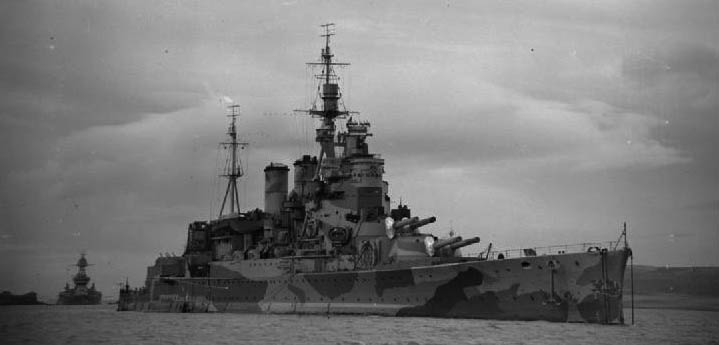
The Renown participated in the Norwegian campaign and faced the Scharnhorst and Gneisenau, damaging her after a brief duel. She underwent basic repairs at Gibraltar, joining the force H and replacing the Hood, which was still her traditional role within the battlecruisers squadron. After participating in various operations in the Mediterranean, she returned to the home fleet in November 1941 to escort the convoys to Murmansk and the North Atlantic. He then returned to force H to support Operation Torch. In June 1943 she returned to UK in drydock to have her on-board aviation removed.
The HMS Renown convoyed Churchill at the Quebec and Cairo conference, then was sent to the Far East for Operation Cockpit, attacking the Japanese bases in Sabang and Sumatra, then Operation Transom against Java and Sumatra, the Nicoban and Andaman Islands. It was placed in reserve in May 1945 and demolished in January 1948.
HMS Repulse
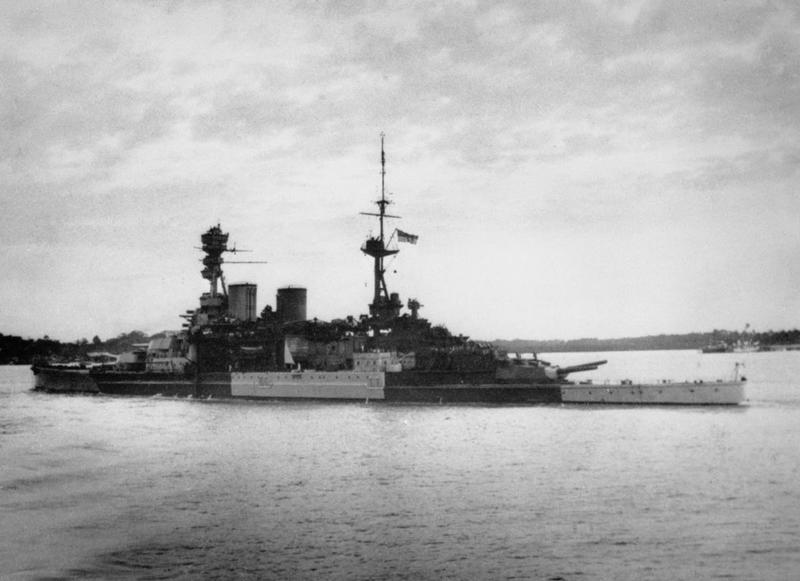
HMS Repulse will never benefit from the same attentions as its sister-ship and its redesigns were superficial. He was part of the squadron of battle cruisers during the years 20-30 with the Renown and the Hood and participated during the war in the hunt for the Graf Spee, and German blockade runners, escorting the Furious and then the Ark Royal, in Norwegian waters, then attempted to intercept KMS Admiral Hipper.
She participated with HMS Renown in the interception of the KMS Scharnhorst, then the KMS Bismarck in May 1941, stalling quickly because of the lack of fuel oil. She would receive additional light AA and a new fire radar, and then sent for troops convoy escort to South Africa. From there she joined the Indian Ocean squadron. Repulse teamed up with the HMS Prince of Wales in Ceylon and then both sailed to form the Singapore-based ‘Force Z’.
On 8 December, the squadron set off to intercept a convoy of Japanese troopships but it was spotted en route by a IJN submersible on picket duty and seaplanes. Their position was communicated to the Imperial staff. Knowing that they were discovered, Admiral Tom Philips tried to get back home during the night, but in the morning around 5:00 a.m. receiving a report of Japanese troops landings at Kuantan, they changed course again to surprise them. The squadron however was spotted again, and attacked in force by some 86 bombers of the 86th flotilla based in Saigon, “Betty” bombers and and “Nell” torpedo planes.
Then followed the extraordinary ballet of Commander Bill Tennant to avoid high altitude bombs and torpedoes, lasting more than half an hour, downing two bombers and damaging 8 others, before another wave of 8 “Nell” torpedo-planes in close formation which launched and hit the Repulse in rapid succession by 4 or 5 torpedoes. She sank at 12:23 pm, nringing with her 508 sailors and officers. Survivors were rescued by two destroyers. Force Z had lived. The Renown was now the last battlecruiser in service worldwide (arguably the IJN Kongo class has been so thoroughly modified they were now rather fast battleships).

Author’s profile of HMS renown in 1942
Specifications (Renown 1940)
Displacement: 36 080 t. standard -36 660 t. FL
Dimensions: 242 m x 27,4 m x 9,7 m draft FL
Propulsion: 4 shaft Parsons turbines, 8 Yarrow boilers, 120 000 hp. Top speed 29 knots, 5,000 nm at 12 knots.
Armour: Main casemate 355 mm, decks 160 mm, telemeters 152 mm, turrets 406 mm, barbettes 38 mm, CT 343 mm.
Armament: 6 x 381 mm (3×2), 10 x 113 mm (5×2) DP, 24 x 40 mm AA (3×8), 3 Walrus seaplanes.
Crew: 1200
Src/Read More
Conway’s all the world’s fighting ships 1906-21 and 1922-47
http://www.fr.naval-encyclopedia.com/2e-guerre-mondiale/royal-navy-2egm.php#cuir
Brown, David K. (2003). The Grand Fleet: Warship Design and Development 1906–1922
Burt, R. A. (1993). British Battleships, 1919-1939.
Campbell, John (1985). Naval Weapons of World War II.
Johnston, Ian (2011). Clydebank Battlecruisers: Forgotten Photographs from John Brown’s Shipyard.
Campbell, N. J. M. (1977). “Washington’s Cherry Trees, Part 1-3”.
Raven, Alan; Roberts, John (1976). British Battleships of World War Two: The Development and Technical History of the Royal Navy’s Battleship and Battlecruisers from 1911 to 1946.
en.wikipedia.org/wiki/G3_battlecruiser
The models corner:
N3 class battleship St Andrew model kit review
HMS Hood (1918)
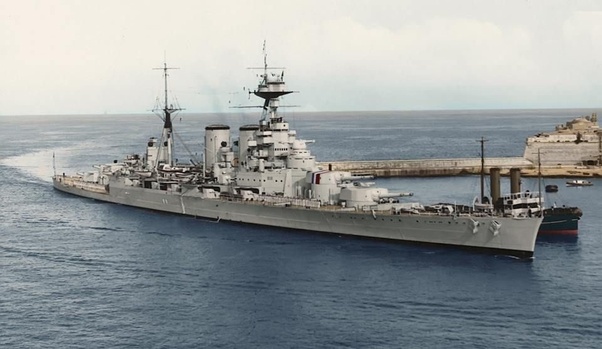
The HMS Hood was exceptional for more than one reason: She was the last British battlecruiser and one of the last in service in the world (the Japanese Kongo class ships had their protection so reinforced that they were classified like “fast battleships”.). She was especially the steel ambassador of the entire Royal Navy, his pride like that of the country. She sailed on all seas, stopped in all ports, and proudly displayed the flag, during a peaceful career which lasted from 1921 to 1941.
She was finally the most powerful warship in the world at its launch and remained such until these disastrous days in May 1941, at least in the minds of the average citizen reading newspapers in mainland. So a symbol. But the aura of a symbolism cannot protect an outdated concept. This is what the hood bitterly and violently demonstrated painfully. Its other share of celebrity is due to its legendary (but short) duel of artillery with the new most powerful warship of the world, black beast of the British and in particular of Winston Churchill: The battleship Bismarck.
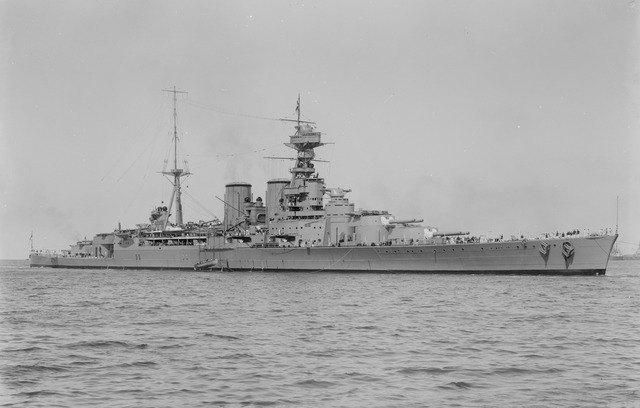
Design
The Hood was first and foremost plagued by an armor designed on plans before the Battle of Jutland. The parabolic shots were then considered too uncertain (from the point of view of the British, whose pointing tools had very average precision) to constitute a sufficient risk to weigh the ship down. It was therefore sacrificed on the altar of the sacrosanct speed. However, the Germans, as they showed precisely during this engagement, put much more blows to the goal. But this warning was not followed by the addition of real protection thereafter, and when the Bismarck engaged it, the result was clear and without burr.
Ordered during the war, before the Battle of Jutland (March 1916), and her keel laid in September 1916, the Hood was launched to John Brown on August 22, 1918, but completed after the war, to be accepted in active service on May 15 1920. Compared to the previous Repulse, she was a perfect example of the “always more” that prevailed in the admiralty of the time, a race which the treaty of Washington (1922) came to end.
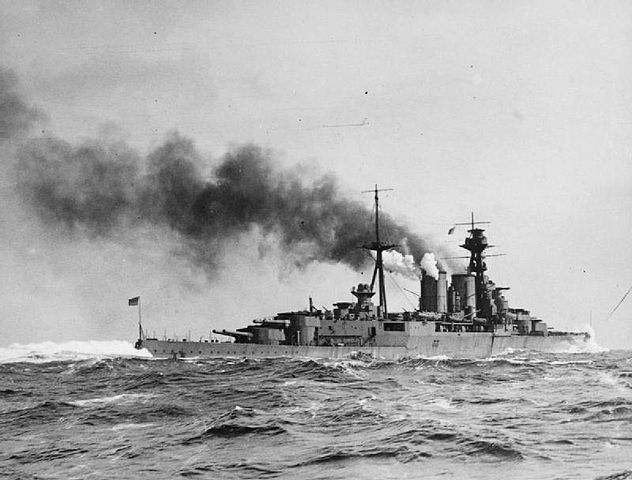
At the same time, she witnessed the cancellation of the series, the four other “admiral class” sister-ships, which would have been accepted in service around 1922-24. The Hood was 33 meters longer, 4 inches wider, and almost 10,000 tonnes heavier, with two additional 380 mm pieces than the previous Renown. She was therefore de facto the most powerful warship ever built in the world. She remained so until the end of the 1930s. But as a battle cruiser, and because of the will of John Jellicoe and David Beatty, her protection remained – in theory – speed. However, this type of ship could, if necessary, cross iron with a battleship – from a distance, using her range. In truth, in no way was she ready to fight the Bismarck, of a whole other generation, that of fast battleships, marrying the “best of both worlds” in a terrifying package. But at the time she was the admiralty’s only match for the mighty German battleship.
Career
The Hood, however, benefited from a few concessions to progress, in particular a more efficient AA made up of 40mm Bofors. However, its fire control was obsolete, like most of its detection and telemetry equipment. The “major overhaul” was to take place between the end of 1939 and mid-1941 but the war put an end to this attempt. The Hood was requisitioned urgently, we could not do without it. The Hood therefore began a series of interdiction patrols to the German fleet between Iceland and the coast of Norway. Then he joined force H in the Mediterranean and participated in Operation Catapult in August 1940 against the French fleet stationed in Mers-el-Kébir.
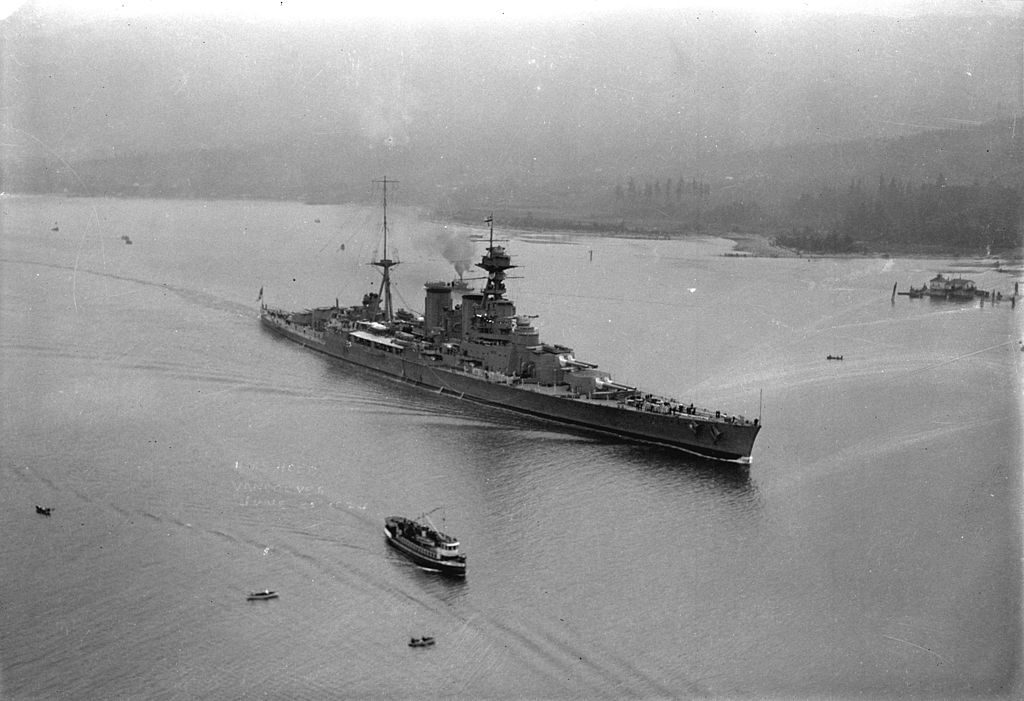
Hood in Vancouver
Back at Scapa flow he stayed there to intervene in the event of a German invasion in the Channel (“Sea Lion” operation). He was later joined by the Prince of Wales. The threat of an invasion was temporarily repelled with the success of the Battle of Britain, but a new threat began to emerge. In May 1941, it took shape. The Bismarck accompanied by the Prinz Eugen attempted an outing in the Atlantic. It was however intercepted by the Hood group, a priori on paper a definite advantage, but as the protection and fire control of the Hood were obsolete, the Prince of Wales was too recent and not yet fully operational. But Churchill’s order was clear: “sink the bismarck”.
The engagement was brief for the Hood, it started to fire at a distance of 16500 meters. The first burst of Birmarck was too short, but the second hit the nail on the head. All of the Prince of Wales sailors saw this terrifying spectacle, of a greater spray of fire than the battle cruiser itself, spurting out from the aft mast as the hull lifted and deformed under enormous pressure. Everyone understood on board: One of the shells had hit the ammunition compartment. The ship, cut in half and on fire, sank very quickly, taking almost all of its crew. There were three survivors.
In 2001 the Hood wreck was rediscovered, which was the subject of a BBC report. However, an in-depth examination of where the explosion started did not solve the puzzle of the exact cause of the explosion. Indeed, the descriptions and drawings made of the explosion put their finger on a problem: It had started far from the rear ammunition compartment. There was practically nothing there that would cause it, or at least not on this scale. To date the hypotheses are going well but the truth is still eluding specialists …

Author’s illustration – HMS Hood in May 1941
Specifications (Hood 1941)
Displacement: 42 670 t. standard -45 200 t. FL
Dimensions: 262,20 m x 31,7 m x 8,7 m FL
Propulsion: 4 shaft Brown-Cirtis turbines, 24 Yarrow boilers, 120 000 hp. Top speed 31 knots, 8,000 nm at 12 knots.
Armour: Belt 300 mm (12 in), turrets 381 mm (16 in), telemeters 150 mm (6 in), decks 100 mm (4 in), CT 280 mm (11.8 in).
Armament: 8 x 16-in/381 mm (4×2), 14 x 4-in/113 mm (7×2) DP, 8 x 40 mm AA, 1 RL AA.
Crew: 1477
Queen Elisabeth class battleships (1913)
Queen Elizabeth, Warspite, Barham, Malaya, Valiant




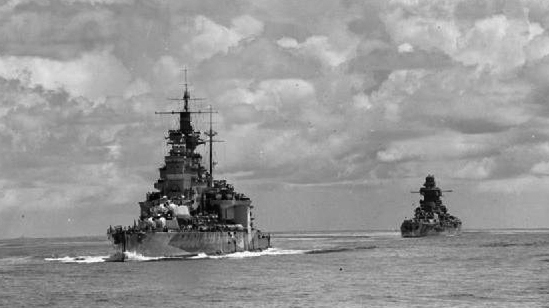
HMS Valiant and Richelieu in the far east 1944
Veterans of two Wars
The Queen Elizabeth class of 1913 were already made famous by World War I, appreciated for their tremendous firepower, speed, and modern oil-fired boilers. This was a new generation of battleships, still in the tradition of dreadnoughts initiated in 1906, but already looking forward to the next generation of “super battleships”. These ships were commissioned during the Great War (1915-16), were deployed in activity with the home fleet, which formed a squadron renowned during their only truly offensive deployment, under the command of Admiral Jellicoe during the Battle of Jutland in May 1916.

The class included Queen Elizabeth, Valiant, Warspite, Malaya and Barham. Unquestionably, their main advantage lay in their 8-piece, 381-mm artillery, whose range and impact were formidable at the time. But already at that time we plunged on 406 mm pieces, and the British even put into service (shortly) battle cruisers with 460 mm pieces, which were converted into aircraft carriers (the Furious and Courageous).
They were with the more recent Revenge the spearhead of the Home Fleet throughout the interwar period, seeing their predecessors scrapped for the sake of the Washington Treaty. Their only survivor was HMS Iron Duke, of the previous class, who served as a gunnery school ship during the war. By 1933, however, they had aged and their modernization was being considered.
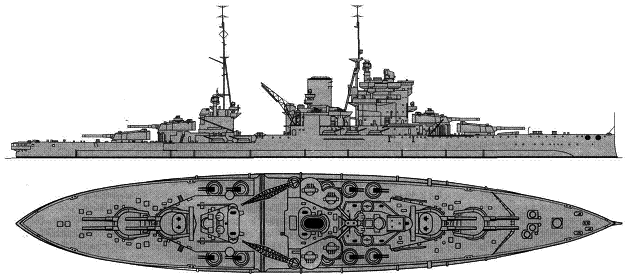
Blueprint of the Valiant and Queen Elisabth after reconstruction
Some suggested that the plans for abandoned warship projects in 1920, alternative plans for Nelson (1925), and preparatory plans for the future class of battleships in the post-moratorium, could find practical application: battleships of the Queen Elizabeth class. However, for budgetary reasons (we were affected by the crisis of 1929), we deployed this reconstruction plan on only three units: The Warspite (nicknamed “old lady”, and was the first), the Queen Elizabeth, and the Valiant, Malaya and Barham, like the following Revenge, were only modernized in a rather drastic way.

HMS Barham, Malaya and Argus
The great refit of 1936
– First refit: HMS Warspite, completed in 1937 and cost 2 million pounds. The Warspite emerged with increased width, better protection, bulges, a new powertrain (trees, propellers, boilers, etc.), new rangefinders and a new massive and spacious gangway superstructure. He kept some of his 152 mm pieces and was given four 102 mm doubles, as well as four 40 mm octuples and four 7.9 mm quadruples. Shortly before the war, he was given a radar, which proved decisive during his engagements in Norway and the Mediterranean. The Warspite had a good career, on almost all theaters of operation of the Royal Navy.
– Second refit concerned the Valiant, rebuilt in 1927-30, and between 1937 and 1939 in Devonport. His redesign served as a model for Queen Elizabeth. The Valiant participated in the operation of Mers el Kebir, at the Battle of Cape Matapan, at the ridge, and in December 1941, he was put out of action for many months because of a mine in Alexandria posed by the divers Italians. In 1943, he participated in operations in Sicily and Italy (Salerno), then was sent to the Far East and fought the Japanese in Indonesia.
– Third refit, the Queen Elizabeth, modernized in 1926-27, then in 1937-41. This redesign was even more advanced than the Warspite because, among other things, the secondary armament in barbettes was removed, and 10 double carriages of 114 mm added instead. the AA armament was also reinforced and its electronic equipment modernized. Queen Elizabeth spent most of her career in the Mediterranean. It was sunk in shallow waters in Alexandria by Italian swimmers and immobilized for almost a year of salvage and work.
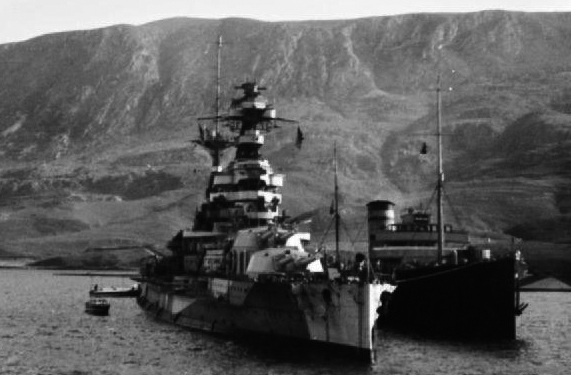
HMS Barham in Suday Bay 1941
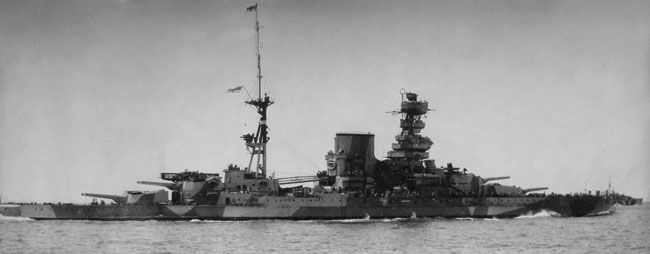
HMS Barham underway in 1941, shortly before her demise – notice the truncated funnel of the first early refit
QE class specifications 1940 |
|
| Dimensions | 195 m long, 31.7 m wide, 9.8 m draft. |
| Displacement | 30,000 t. standard -36 500 t. Full Load |
| Crew | 950 officers and enlisted men |
| Propulsion | 4 propellers, 4 Parsons turbines, 8 Admiralty boilers, 80,000 hp. |
| Speed | Top speed 23.5 knots. |
| Range | ? nm at 12kts |
| Armament | 8 pieces of 381 (4×2), 20 pieces of 114 mm (10×2), 32 of 40 mm AA, 20 to 52 of 20 mm, 2 seaplanes. |
| Armor | 330 mm belt, 152 mm central reduction, 330 mm turrets, 278 mm bunker. |
Revenge class battleships (1915)
Revenge, Ramillies, Resolution, Royal Oak, Royal Sovereign.
The “R” class battleships enlisting again in WW2

Colorized photo of HMS Revenge by Irootoko Jr.
Launched shortly after the Queen Elisabeth class and commissioned from 1916 to 1917, the five Revenge class battleships, sometimes referred to as the Royal Sovereign class, were designed to be more “economical” while retaining the essential of the previous dreadnoughts. Dimensions, the tonnage, and propulsive apparatus were reduced (notably by the number of boilers).
So their speed and range were, therefore, lower, but they retained their impressive 15in (381 mm) artillery then almost unparalleled in Europe: German battleships of the Baden class were the only ones competing, late in the war. Some compromises with supplies were also made by a return to mixed heating, by coal and oil, initially for fear of a lack of oil supplies in wartime.
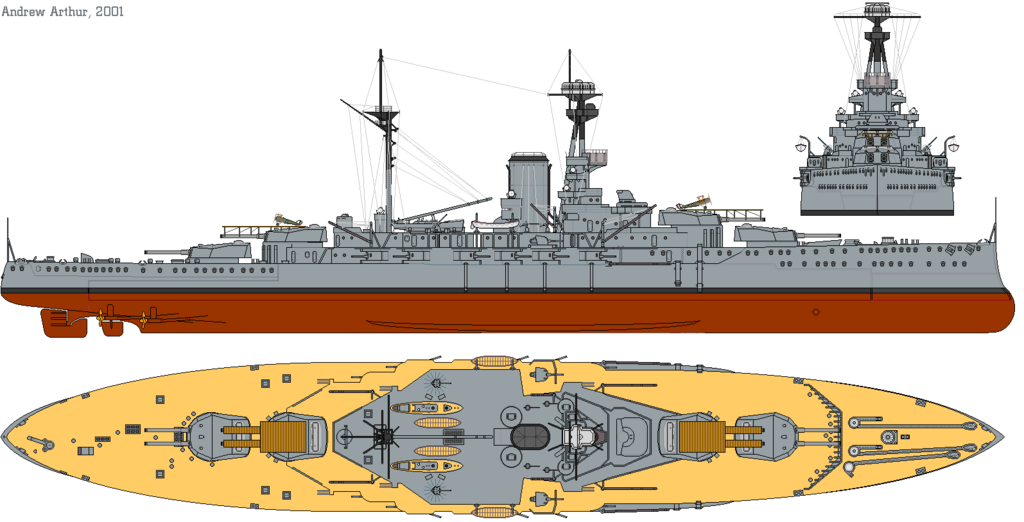
Profile of the class in 1916 (wikimedia commons)
In the end these ships looked more stocky and their unique funnel had them immediately recognized from the previous battleships. The class included HMS Revenge, Ramillies, Resolution, Royal Oak, and Royal Sovereign. Armor protection for these ships was reviewed and quite different from the previous Queen Elizabeths: The armored bridge was much higher, side armor were made thicker, reaching 13 inches (330 mm). This scheme was chosen because at the time the Revenge was designed, the Admiralty still believed that the fleet engagements would take place at a relatively close distance, and so that the main danger would came from direct fire on the flanks, rather than high angle plunging fire striking the deck. Moreover, this change in armor arrangement was a seen as a measure of economy.

HMS Royal Oak in 1937.
Refits
The previous Queen Elisabeth had conical plate reinforcements at the top and bottom of the armored belt, which were extremely expensive to produce. Overall, it was probably an effective scheme but quickly rendered obsolete by developments in naval artillery, aviation, and tactics that, unfortunately, evolved almost immediately after the ships entered service. Later, they were given added anti-torpedo Bulges on the flanks, which provided excellent protection in theory against torpedo attacks in the thirties, but because of the rise of new torpedoes warheads, proved insufficient for the Royal Oak when she met her fate in 1939…
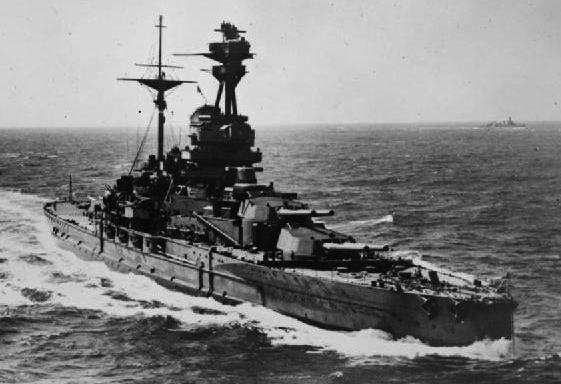
HMS Revenge, date unknown (IMW)
Another of their most important characteristics was their stability, voluntarily sacrificed to give them a better elevation for the artillery. This made any further modernization difficult if not impossible: Thus, total reconstructions such as the Warspite or Valiant ones where it was necessary to add nearly 3000 tons of additional steel for superstructures, new rangefinders, AAA, etc. were out of question.
As a result, the “redesign” of these five ships was rather superficial: It consisted in modernizing their powerplant, turned after the war to “all-oil”, improving their endurance, saving space and allowing for extra anti-torpedo ballasts in 1922-24. In 1928, two of their barbette guns were eliminated in favor of modern dual-purpose 102 mm turrets, four being mounted on the central superstructure. Submarine torpedo tubes were removed from 1931, but two and then two more Octuples 40 mm Bofors were quickly added to bolster their AA defence, for a total of 2-pdr 32 guns and from 12 to 16 single Oerlikon guns in 1941.
Subsequently, until 1941, they received up to 40 of these 20 mm guns to increase their survivability. Fortunately, none suffered a fatal air attack, their protection focusing on the side shield was thus never put in default. On the other hand it was not the same for submarines.
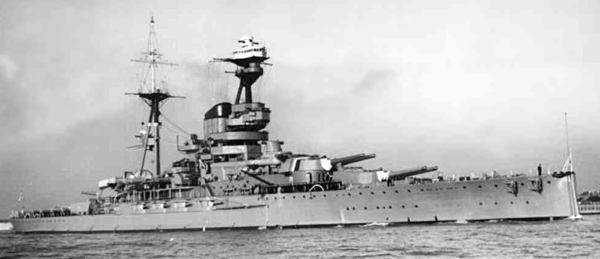
HMS Resolution
The Revenge class in action
In operation, the five battleships were considered less efficient than the previous Queen Elisabeth and were somewhat relegated to less active posts. They all participated in convoy escorts from 1939. They were based at Scapa Flow, in the event of a Kriegsmarine raid in force against the convoys. This was an interception and in no way chase, because their speed was no match to that of German battleships. Scapa Flow was judged by the admiralty and the press as “inviolable”.
So this came as a shock for the Nation when the HMS Royal Oak was sunk, then anchored on November 14, 1939, by Commander Gunther Prien’ U47, making a hero return in Germany… Later in operations, the Ramillies and the Resolution were also torpedoed, but their ballasts damped the shock, and they were able to regain an harbor for repairs.
The Royal Sovereign, as part of Russian aid in Murmansk convoys, was eventually to the Soviet Navy, taking the name of Arkhangelsk in 1944. She escorted the convoys in anticipation of a Norway-based Kriegsmarine attack. She was returned to the Royal Navy in 1948, put in reserve and scrapped soon after, a fate rather similar, of later than the other battleships of the class.
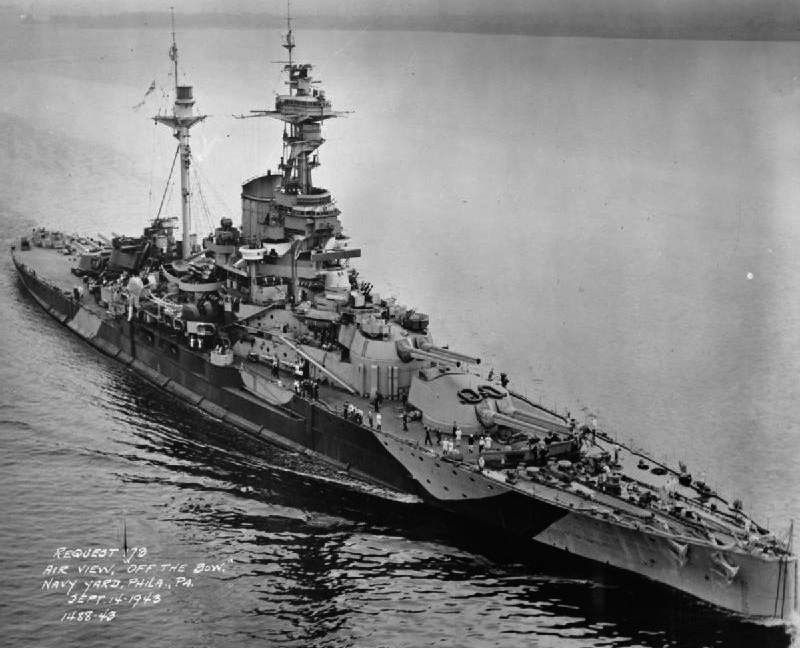
HMS Royal Sovereign at Philadelphia in 1943

HMS Ramillies in 1941 off Dakar, Operation Menace.
Royal Sovereign 1940 specifications |
|
| Dimensions | 190 m long, 30 m wide (27 origin), 8.7 m draft. |
| Displacement | 28,000 t. standard -34 510 t. Full Load |
| Crew | 997 |
| Propulsion | 4 propellers, 4 Parsons turbines, 24 Admiralty boilers, 26,500 hp. |
| Speed | Maximum speed 21 knots, RA 5000 nautical at 12 knots. |
| Armament | 8 pieces of 381mm cal 42 (4×2), 12 Mk XII 152 mm in barbets, 8 x 102 mm AA (4×2), 32 x 40 mm AA, 52 x 20 mm, 2 seaplanes. |
| Armor | 330 mm belt, 127 mm bridge, 278 mm central reduction, 330 mm turrets, 254 mm barbettes, 278 mm bunker. |

HMS resolution in the Indian Ocean

Arkhangelsk in 1944, ex Royal Sovereign transferred to the Soviet Navy to secure the road to Murmansk (cc)
The post-Jutland battleships: Nelson class
Genesis of the design
The Nelson are interesting and atypical battleships. They were compromises directly derived from designs developed in 1918-1920 that took into account the lessons of the Great War at sea, and especially and especially the Battle of Jutland, the only major commitment or the ships of the line were seriously tested. Most naval engagements of the Great War were skirmishes of battle cruisers.
On the other hand, Jutland showed the limits of their concept. Against other similar buildings (here in this case Germans), protection was essential. The British losses were mainly attributed to this undeniable factor: The protection of German buildings comparable was much better, as the engineers discovered much later by analyzing the wrecked Hindenburg wreck at Scapa Flow in 1919.
The many designs that were developed by the admiralty thus consisted in tending towards a battleship battle cruiser model, in fact the prototype of the “super-dreadnought”. Thus in the cartons, were developed battleships of the type G3 armed with 406 mm pieces and others type N3 armed with parts of the type N3, 457 mm. All the other nations of the time were thrown into the same escalation of power and tonnage.
The treaty of Washington (1922) came to put a good order. In particular, it halted the continuation of the construction of the Hood (1920), leaving the latter without sister-ship and killing in the ouef most projects, stopping net construction of other buildings in progress.
Thus, it is by modifying the plans of the G3 that the Admiralty managed to render “in conformity” with the treaty their future Nelson. But this inevitably led to many compromises in order to satisfy the treaty while at the same time protecting the armament / protection / speed balance. In fact they were nicknamed after their entry into service as the class of “Cherry tree”, the “trees pruned in Washington”.
The “dry” displacement (excluding oil and ballast) projected was 35,000 tonnes. The main artillery was placed in the front, not to counter the conventional tactic of “bar the T”, but to reduce the weight of the armor by restricting the length of the battleship.
Innovations and characteristics:
Artillery was signalled by their triple turrets for the first time, firing lighter shells, but with higher velocity, like German battleships of the Great War. For the first time an advanced semi-electronic fire control system was used for direct AAA and an Admiralty Fire Control Table Mark I was setup for main artillery fire.
The secondary armament was of course no longer in barbettes, distant legacy of side artillery, but in semi-automated turrets placed aft. For protection the general principle was “all or nothing” armor scheme. It was generally internal, notably using deflecting and non-straight surfaces. Many compromised led to ways to diffuse eneregy as well as blocking hits.
On the other hand, for the first time, they had a true battleship armoured deck, designed to deal with plunging parabolic fire and aircraft hits. Machinery was reworked and since the 1906 dreadnought they returned to a two propellers configuration. They also adopted more efficient boilers and oil heating, therefore a single truncated funnel was now sufficient. The hull was hydro-dynamically trimmed for maximum efficiency, but top speed was was limited to 23 knots, not really an improvements over previous “super dreadnoughts”.
Launch and trials
HMS Nelson and Rodney were started in 1923-24, launched in 1925-26 and completed in 1927. They partially reused material from cancelled battleships after the 1922 treaty ban. They were still not indeed “fast battleships” because of many concessions made to limit their tonnage. Their particular superstructure was soon nicknamed “queen anne’s mantion”. Created to save weight, this quite unique structure largely used aluminum. On decks, fir tree was also widely used rather than teak, also as a weight-saving measure. The position and shape of the bridge superstructure, and embedded conning tower acted as a “sail”, which distorting maneuvers at low speed. Both were not agile either, having a very long turning circle.
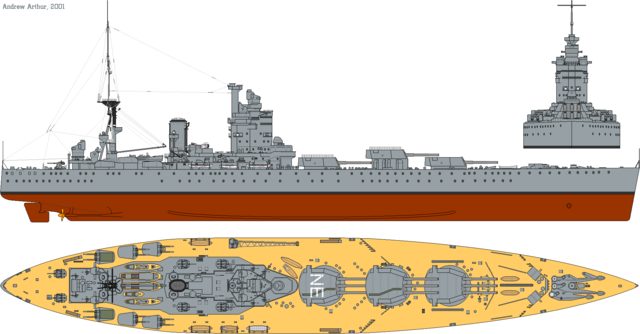
Nelson’s 3-view profile (creative commons)
The peculiarities of the unusual silhouette of this class made it that in 1939 they were nicknamed sarcastically by their crew and were known in the Royal Navy as “Nelsol” and “Rodnol”, in reference to tankers named in “-ol” by that time. Nevertheless they proved their value during the Second World War, often in the foreground. They were modernized only by adding radar and larger AA, mainly quadruple 40mm AA Bofors and Oerlikon 20mm. whereas quadruple Vickers 0.5 in were were considered too light nd removed.
HMS Nelson, was the fourth ship bearing the name of the famous Admiral, built in Newcastle by Armstrong-Withworth, commissioned in August 1927. She became the flagship of Home Fleet based at Scapa Flow. Her crew mutinied in 1931 (Invergordon mutiny). In 1939, both ships participated in escort missions and were based in Scapa with the aim of intercepting German ships passing by the northern route to the Atlantic. They never catch a single one there during their different sorties.
Off the Orkney Islands, HMS Nelson was torpedoed on October 30 by U56. Fortunately, none of the three torpedoes launched exploded. Then in December, she struck a magnetic mine in Loch Ewe and was sent to Portsmouth for extensive repairs lasting until August 1940. She was then deployed to Rosyth to counter a possible invasion in the channel, then in April-June 1941, she was assigned to the Atlantic command.
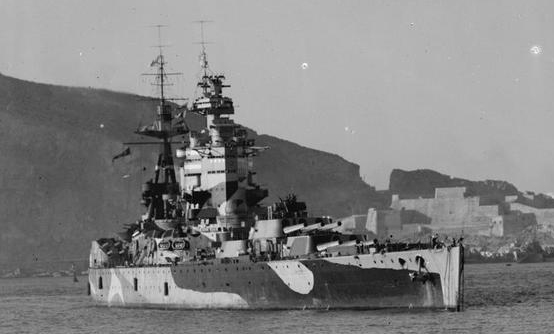
In May, Nelson was in Freetown, East Africa, ordered to enter Gibraltar during the Bismarck chase. After her participation in this episode (she never reached the final fight), she was sent to the Mediterranean to join Force H. She was torpedoed by an Italian aircraft in September 1941 and had to return to UK for repairs until 1942. Later she returned to Force H, was based in Malta, taking part in convoy escort to North Africa. She participated in Operation Torch, in Tunisia, Operation Husky, the invasion of Sicily, and the Italian armistice was signed on board in November 1943 between Eisenhower and Pietro Badoglio.
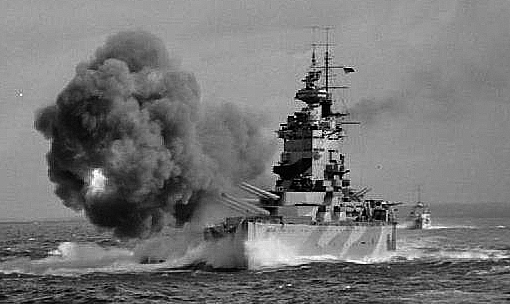
Nelson firing during a gunnery trial
She then returned home for the addition of a powerful additional AA, radars, and was ready to participate to D-Day operations. Damaged by two mines, she was sent for repairs in Philadelphia as British yards were saturated. From January 1945s she was posted to the Far East in Colombo, supporting operations in Burma and Malaysia. In September 1945 she received the surrender of Japanese troops at Penang. Returning home in November, she spent the rest of her service in the home fleet until 1947. Not useful in the context of the cold war she was sent to scrap.
HMS Rodney
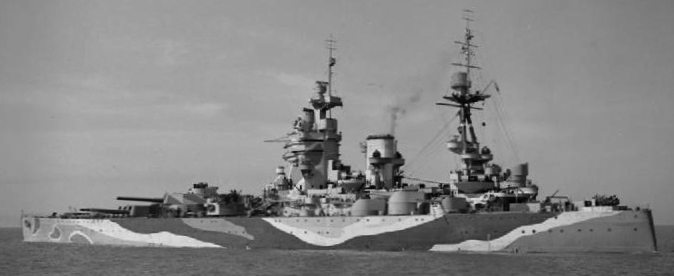
HMS Rodney after a refit at Liverpool.
HMS Rodney had a fairly similar career but owes her fame to her “fight” (execution would be fair) against Bismarck in May 1941. The German Battleships was was still operational although her direction was inoperative. Rodney herself had undergone some work because of her weak rudder. Built in Cammel laird, Birkenhead, and Launched in December 1942, HMS Rodney, named after an admiral -as should have been the Hood class ships- was accepted into service in November 1927.
Her crew took part in the Invergordon mutiny in 1931. In September 1939, she was based with the Home Fleet at Scapa Flow, deployed to escort convoys and blocking their way to Kriegsmarine raiders. Her slow speed did not allow her to do more than Nelson in this role however. Rodney would participate in the fighting in Norway and was hit by a German magnetic aerial bomb which struck her bridge but failed to explode. Repaired Rodney was by March 16, 1941 performing an escort in the North Atlantic, when she spotted the Scharnhorst. However the latter also spotted and recognised her and did not engaged, retiring quickly to safety. Rodney would however fire her guns in anger on the Bismarck with King George V.
During this event, Rodney fire was at first parabolic but as the distance feel, straighter, down to direct fire at short distance. Her heavy shells tearing the German capital ship to pieces. She then retired due to her lack of fuel, and having exhausted virtually all her large caliber ammunition, a fact which alone is saying a lot about the German battleship strength. We now know today that indeed the Bismarck was scuttled in order to sink. After a trip to Boston to care for her engines, Rodney joined Force H in Gibraltar. She operated off Malta, participated in Operation Torch, and the landings of Sicily and Salerno.
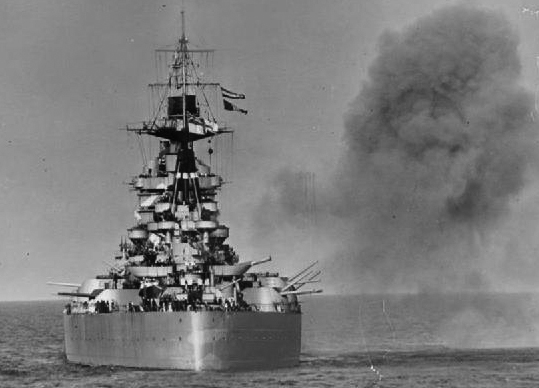
Nelson pounding the Normandy landings fortifications on D Day
In June 1944 she was deployed for the landings at D-Day, shelling fortified points of the Atlantic wall. She took part in convoys back and forth to Murmansk. Because of her multiple turbines problems full modernization was never carried out at the level of HMS Nelson, and was placed in reserve as of December 1944, in Scapa Flow. She was broken up in 1947.
Specifications |
|
| Dimensions | 201 m long, 32 m wide, 9.6 m draft (full load) |
| Displacement | 33,950 t. standard -41 250 t. Full Load |
| Crew | 1361 |
| Propulsion | 2 propellers, 2 Brown-Curtis turbines, 8 Yarrow boilers, 45,000 hp. |
| Speed | Top speed 23 knots, 5000 nautical Radius at 12 knots. |
| Armament | 9 x 406mm Mk I (3×3), 12 x 152 mm (6×2) Mk XXIII, 6 x 102 mm Mk VIII AA, 24 x 40 mm AA (3×8), 16 x 12.7 mm Vickers (4×4), 2 x 622 mm TTs sub. |
| Armor | Citadel 355 mm, 160 mm decks, 152 mm rangefinders, 406 mm turrets, 38 mm barbettes, 343 mm blockhouse. |
King Georges V class battleships (1937)
King Georges V, Prince of Wales, Duke of York, Howe, Anson launched 1937-41
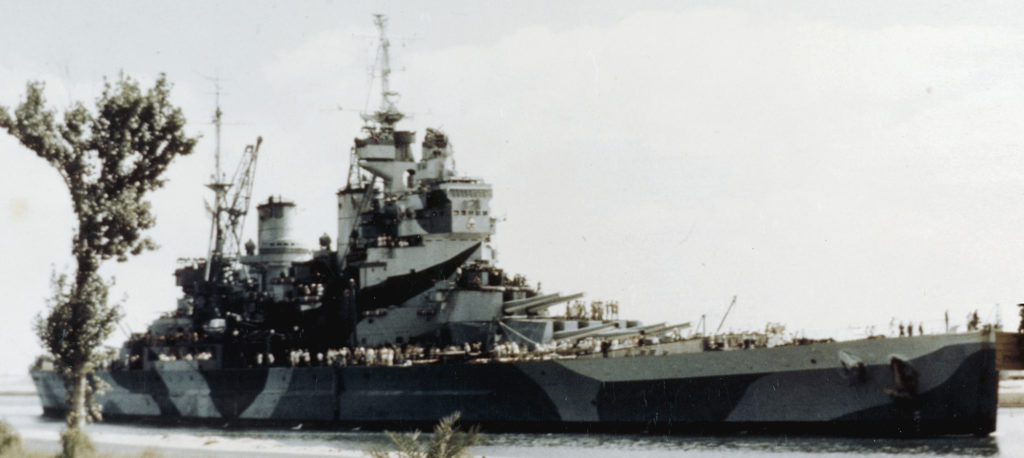
HMS Howe through the Suez Canal to join the far eastern squadron in 1944
The Royal Navy’s first fast battleships, following the ten-year vacancy of the Washington Treaty, were the King George V class. They were the culmination of nearly 15 years of vacation since the post-war design that led to the unusual Nelson and Rodney relied on the new London Treaty (1930) extending the moratorium until 1937.
These battleships were both larger and heavier than the previous ships ast 38,000 standard tons, whereas the old limit was 35,000 tons. The King George V class was also a compromised class returning to a lower caliber (340 mm or 15 inches, compared to 381 mm – 16 inches) because of the treaties. To improve protection, armour was extended over almost the whole ship (no longer all or nothing), and the smaller main guns allowed to placed them in quadruple turrets for the first and last time on British Battleships. The configuration allowed to limit the lenght of armour around vital parts and barbettes, thus making the ship lighter.
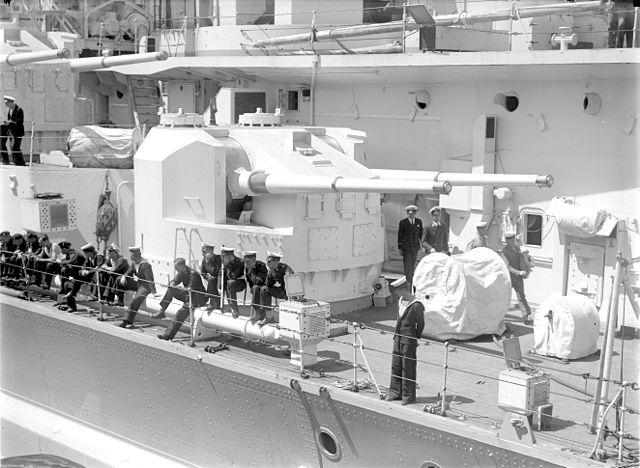
With a twin turret in position B, this gave them ten versus nine on the Nelson, with a substantially equal range and a higher rate of fire. But these new mounts were complex and caused many problems of development even as the war began. Their speed was much higher than that of the Nelson, and they indeed deserved for the first time the title of “fast battleships”.
Design
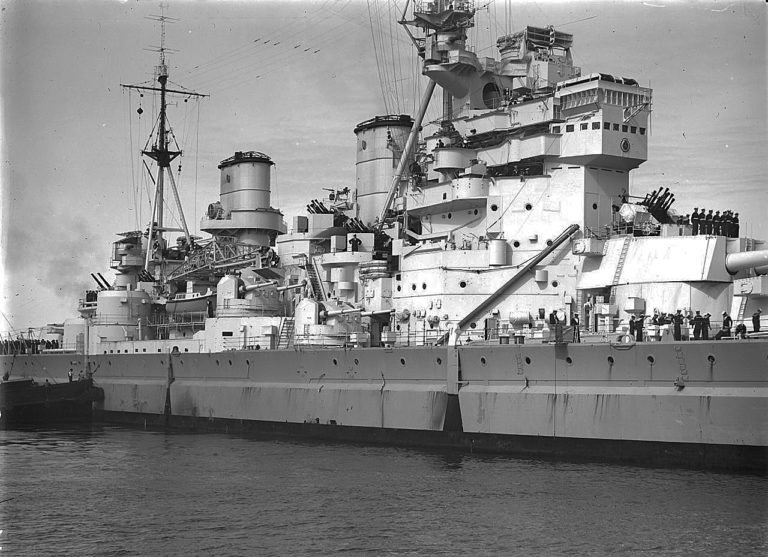
Engines and propulsion
The genesis of this class started in 1937. Compartmentalisation of their engine room was for the first time very neat, with boilers and machines grouped in pairs, to prevent a single shot disabling most of their propulsion. Nominal power output was rated for 110,000 horsepower at 230 rpm, the steam being injected into the tubes at a working heat of 375 ° C.
An emergency system was planned to push the generated output to 125,000 hp or up to 138,000 on the Prince Of Wales. The boilers, from a very successful and long serie, had excellent reliability and great working pressure. However, they were not planned to be operate with high viscosity oil mixed with seawater, a situation forced by shortages after 1942. This resulted in significant losses in boilers, high maintenance and rising costs.
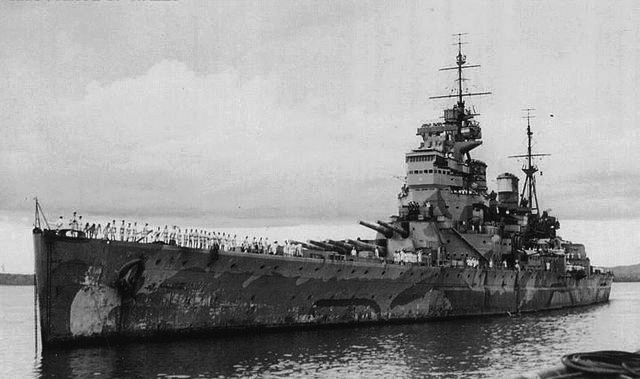
Prince of Wales at Singapore
Armor protection
The armor had been revised and expanded to many, less vital parts of the ship, unlike the “all or nothing” scheme of the previous Rodney. Machinery protection had largely benefited from these attentions. The belt was widened downwards, and the internal subdivision as well, with the central armored caissons lengthened and strengthened considerably. Nevertheless, decks protection against aerial bomb hits still remained barely sufficient for 1935, less so from 1939.
Turret armor was lower, but not that of the ammunitions wells, barbettes and ammunition rooms. On the contrary, ammunition has been greatly increased and better distributed. The Conning tower was also relatively light, wit a roof protected by just 10 cm of armour. The reason was that in practice, officers always visibility on the footbridge over the protected containment of the conning tower.
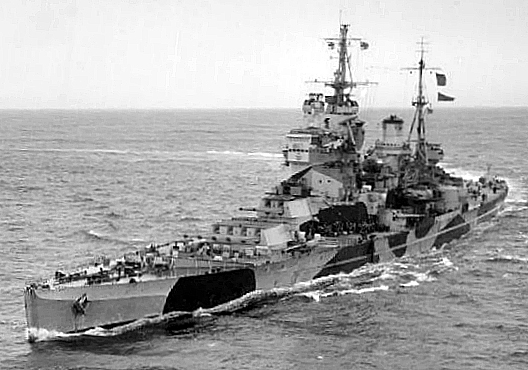
HMS Duke of York at sea circa 1943
Armament
The main armament largely reflected the procrastination of the moment. The first scheme involved a battery of three triple turrets with 15-in guns, but political pressure following the London Treaty forced the admiralty to a reduction down to 14 inches. From that point, quadruple turrets design was envisioned to replace the triple design, which would have given a total of 12 guns (3×4), ideal for saturation fire, and a popular principle in 1936. Howeber in the end, it was seen during the war as mistake, as the neighboring nations soon opted for larger calibers, 15, 16 in or even 18 in.
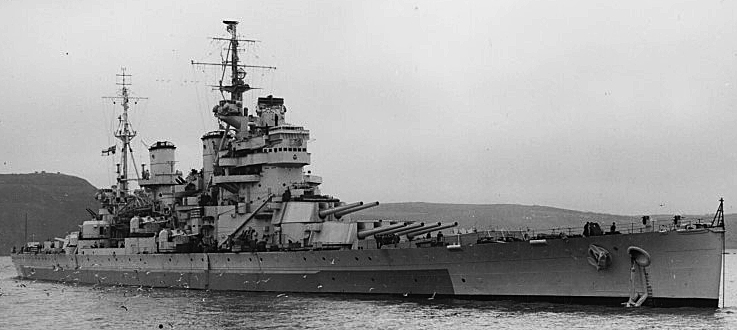
HMS Anson at Devonport 1945
While saber rattling were clearly heard in mainland Europe, the admiralty obtained some liberties towards the treaty and at this point were ready technically to swap to the adpatation of the new 15 in guns. But delays needed for such an operation would have further reduced the entry into active service of the first ship of the class. Construction was carried out with the initial design. In addition the quadruple turrets, entirely new, there were teething problems with maneuvering. In retrospect and regarding the fight with the Bismarck these combined flaws (including the turrets being almost inoperative) almost cost the Royal Navy the Prince of Wales.
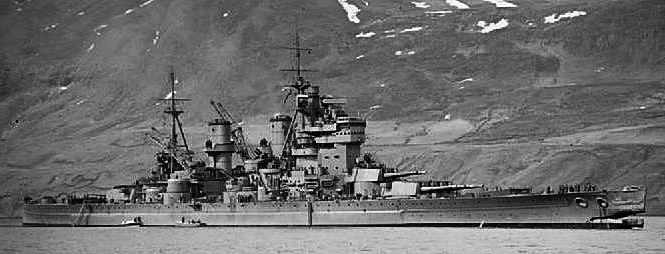
King Georges V showing her prow after ramming an U-Boat in the Atlantic.
The King Georges V secondary artillery was also innovative but accumulated development problems. It was planned to not give them 6-in guns, but a truly versatile dual purpose artillery capable of providing AA cover and against destroyers, torpedo boats down to MTBs. But this was never to be. Adopted on the Dido class cruisers, the new mounts proved disastrous. They were in practice too slow for an effective air defense (as meanwhile aircraft speed had greatly evolved), but it also lacked the hittong power to face the latest destroyers as well. The complexity of the loading system and light shells ended with an anemic 10-12 shots per minute on paper, down in practice to 7-8, and only with very trained crews.
This also explains why the Pince of Wales anti air defense was so weak and ineffective in December 1941. This AA defense was compounded with several quad-40 mm QF2 (“pom-pom”), as well as 20 mm Oerlikon guns and extra Bofors in single mounts, and under mask. This light armament more than doubled during the conflict. In 1945, HMS Anson had sixty-nine 20 mm and nothing less than two hundred 40 mm in octuple mounts.
Career of the King Georges V class
The King George V class finally counted 5 ships in the British tradition, the first entering service in December 1940, and the others (Prince of Wales, Duke of York, Howe, Anson), respectively in March in November 1941, June and August 1942. Their career was splendidly filled and they were of all theaters of operation except the mediterranean.

The Prince of Wales was the only lost in the class, and by an air force. Apart the KGV which pounded the Bismark, and the Duke of York which sank the Scharnhorst, the four ships had relatively unevenful career. As early as 1938, their replacement by a new class, this time equipped with the standard 16-in artillery (in three triple turrets), was ordered, and the first two were started in September 1939. But the lack of materials, manpower and priorities caused them to be suspended and then canceled (Lion class). The last British battleship turned out to be the Vanguard (1947), inheriting the artillery of a decommissioned battle cruiser.

Author’s ilustration of the Prince of Wales


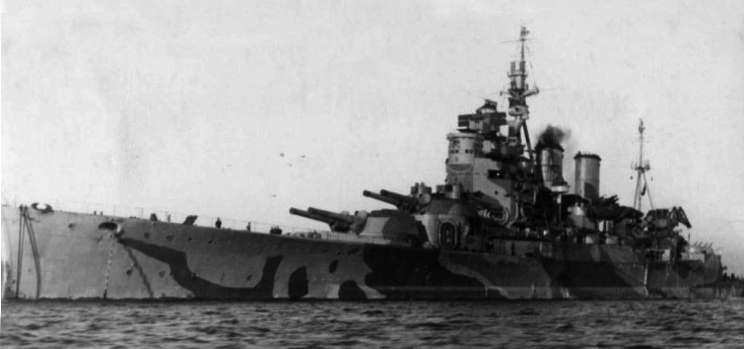

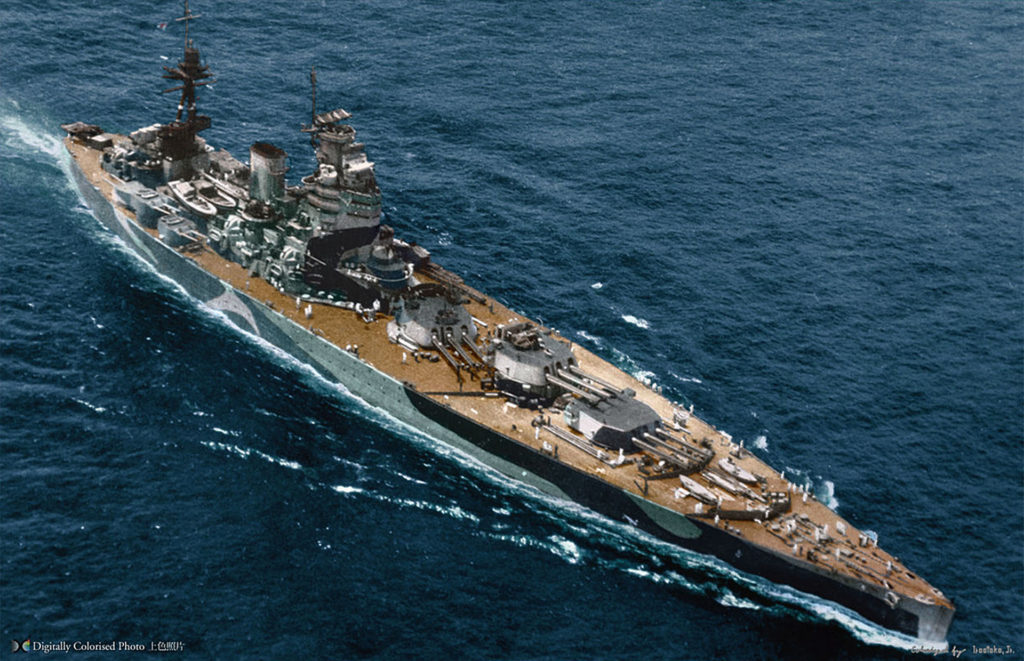
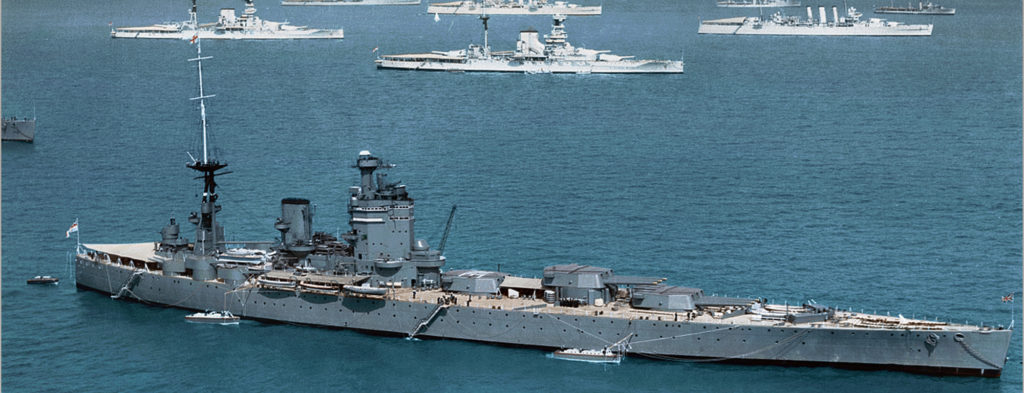
 Latest Facebook Entry -
Latest Facebook Entry -  X(Tweeter) Naval Encyclopedia's deck archive
X(Tweeter) Naval Encyclopedia's deck archive Instagram (@navalencyc)
Instagram (@navalencyc)





 French Navy
French Navy Royal Navy
Royal Navy Russian Navy
Russian Navy Armada Espanola
Armada Espanola Austrian Navy
Austrian Navy K.u.K. Kriegsmarine
K.u.K. Kriegsmarine Dansk Marine
Dansk Marine Nautiko Hellenon
Nautiko Hellenon Koninklije Marine 1870
Koninklije Marine 1870 Marinha do Brasil
Marinha do Brasil Osmanlı Donanması
Osmanlı Donanması Marina Do Peru
Marina Do Peru Marinha do Portugal
Marinha do Portugal Regia Marina 1870
Regia Marina 1870 Nihhon Kaigun 1870
Nihhon Kaigun 1870 Preußische Marine 1870
Preußische Marine 1870 Russkiy Flot 1870
Russkiy Flot 1870 Svenska marinen
Svenska marinen Søværnet
Søværnet Union Navy
Union Navy Confederate Navy
Confederate Navy Armada de Argentina
Armada de Argentina Imperial Chinese Navy
Imperial Chinese Navy Marinha do Portugal
Marinha do Portugal Mexico
Mexico Kaiserliche Marine
Kaiserliche Marine 1898 US Navy
1898 US Navy Sovietskiy Flot
Sovietskiy Flot Royal Canadian Navy
Royal Canadian Navy Royal Australian Navy
Royal Australian Navy RNZN Fleet
RNZN Fleet Chinese Navy 1937
Chinese Navy 1937 Kriegsmarine
Kriegsmarine Chilean Navy
Chilean Navy Danish Navy
Danish Navy Finnish Navy
Finnish Navy Hellenic Navy
Hellenic Navy Polish Navy
Polish Navy Romanian Navy
Romanian Navy Turkish Navy
Turkish Navy Royal Yugoslav Navy
Royal Yugoslav Navy Royal Thai Navy
Royal Thai Navy Minor Navies
Minor Navies Albania
Albania Austria
Austria Belgium
Belgium Columbia
Columbia Costa Rica
Costa Rica Cuba
Cuba Czechoslovakia
Czechoslovakia Dominican Republic
Dominican Republic Haiti
Haiti Hungary
Hungary Honduras
Honduras Estonia
Estonia Iceland
Iceland Eire
Eire Equador
Equador Iran
Iran Iraq
Iraq Latvia
Latvia Liberia
Liberia Lithuania
Lithuania Mandchukuo
Mandchukuo Morocco
Morocco Nicaragua
Nicaragua Persia
Persia San Salvador
San Salvador Sarawak
Sarawak Uruguay
Uruguay Venezuela
Venezuela Zanzibar
Zanzibar Warsaw Pact Navies
Warsaw Pact Navies Bulgaria
Bulgaria Hungary
Hungary

 Bundesmarine
Bundesmarine Dutch Navy
Dutch Navy Hellenic Navy
Hellenic Navy Marina Militare
Marina Militare Yugoslav Navy
Yugoslav Navy Chinese Navy
Chinese Navy Indian Navy
Indian Navy Indonesian Navy
Indonesian Navy JMSDF
JMSDF North Korean Navy
North Korean Navy Pakistani Navy
Pakistani Navy Philippines Navy
Philippines Navy ROKN
ROKN Rep. of Singapore Navy
Rep. of Singapore Navy Taiwanese Navy
Taiwanese Navy IDF Navy
IDF Navy Saudi Navy
Saudi Navy Royal New Zealand Navy
Royal New Zealand Navy Egyptian Navy
Egyptian Navy South African Navy
South African Navy






























 Ukrainian Navy
Ukrainian Navy dbodesign
dbodesign
In your text of capital ships lost in action you stated that H.M.S.Renown was lost in action in 1941 as part of Force Z. I am afraid you are mistaken. It was H.M.S Repulse that was lost, along with Prince of Wales. H.M.S Renown survived the war. Also my uncle served on H.M.S. Renown.(Mother’s brother, he also survived the war.
I knew it was repulse, but the paragraph was somewhat misleading as written, it had been reformulated. Thanks !